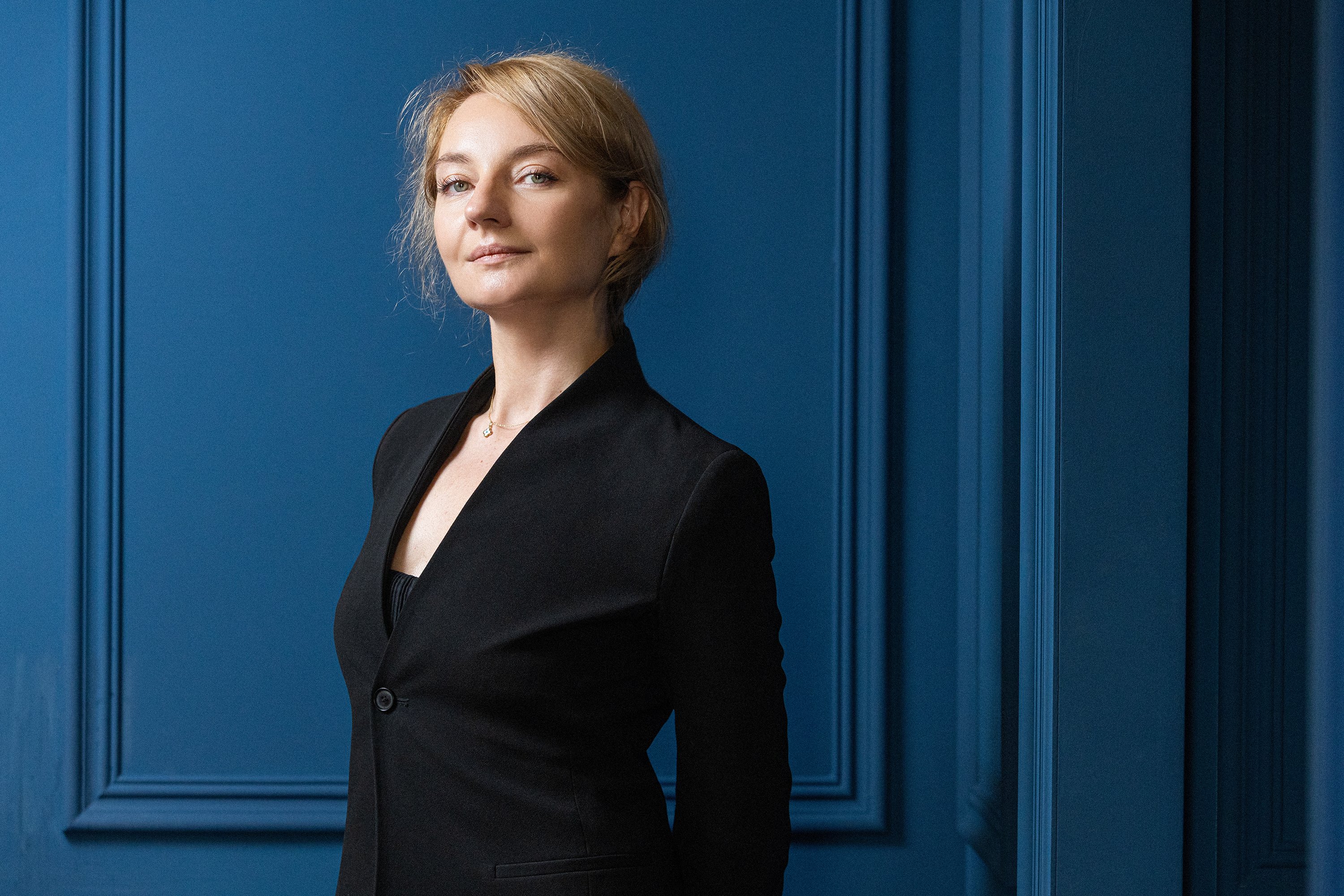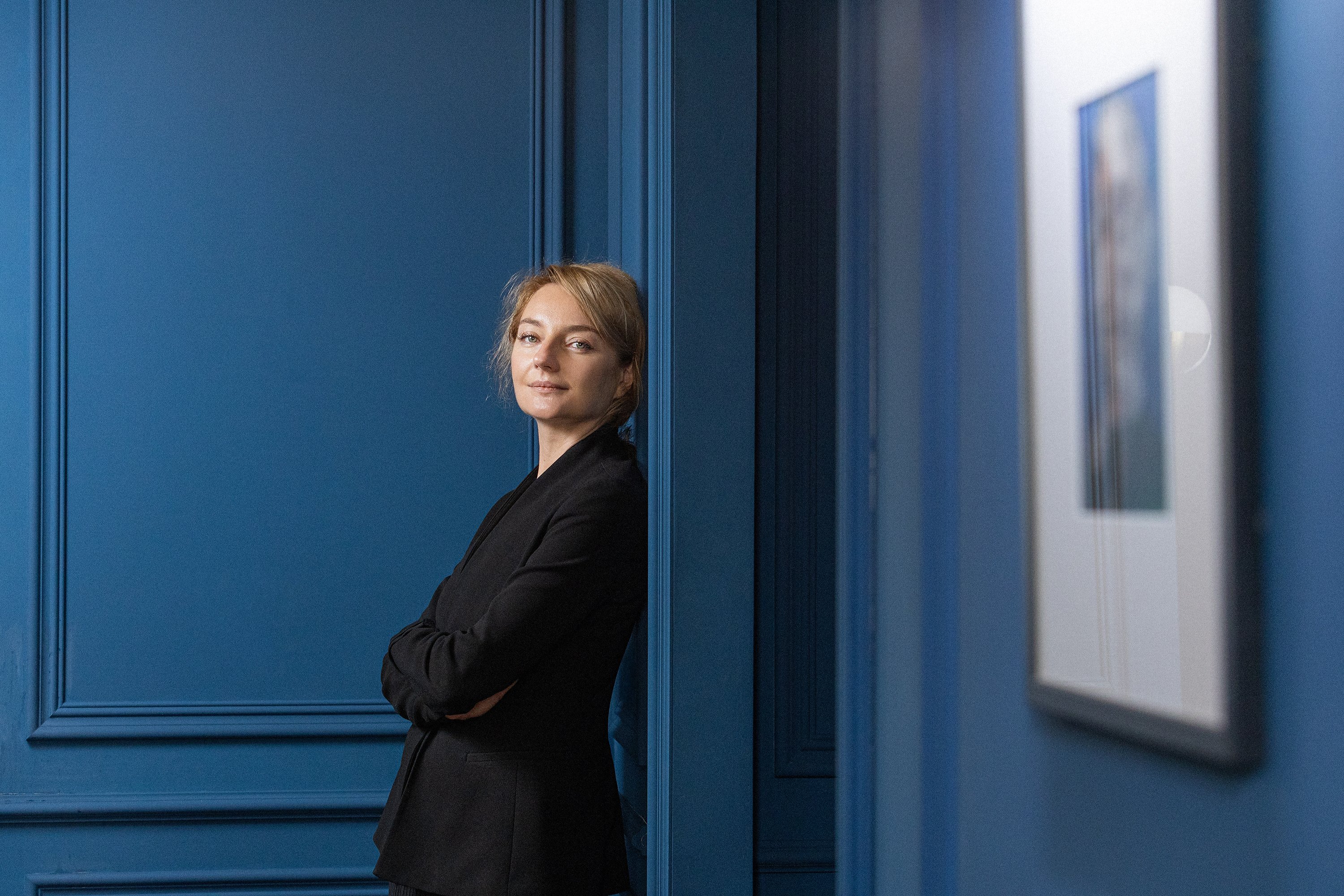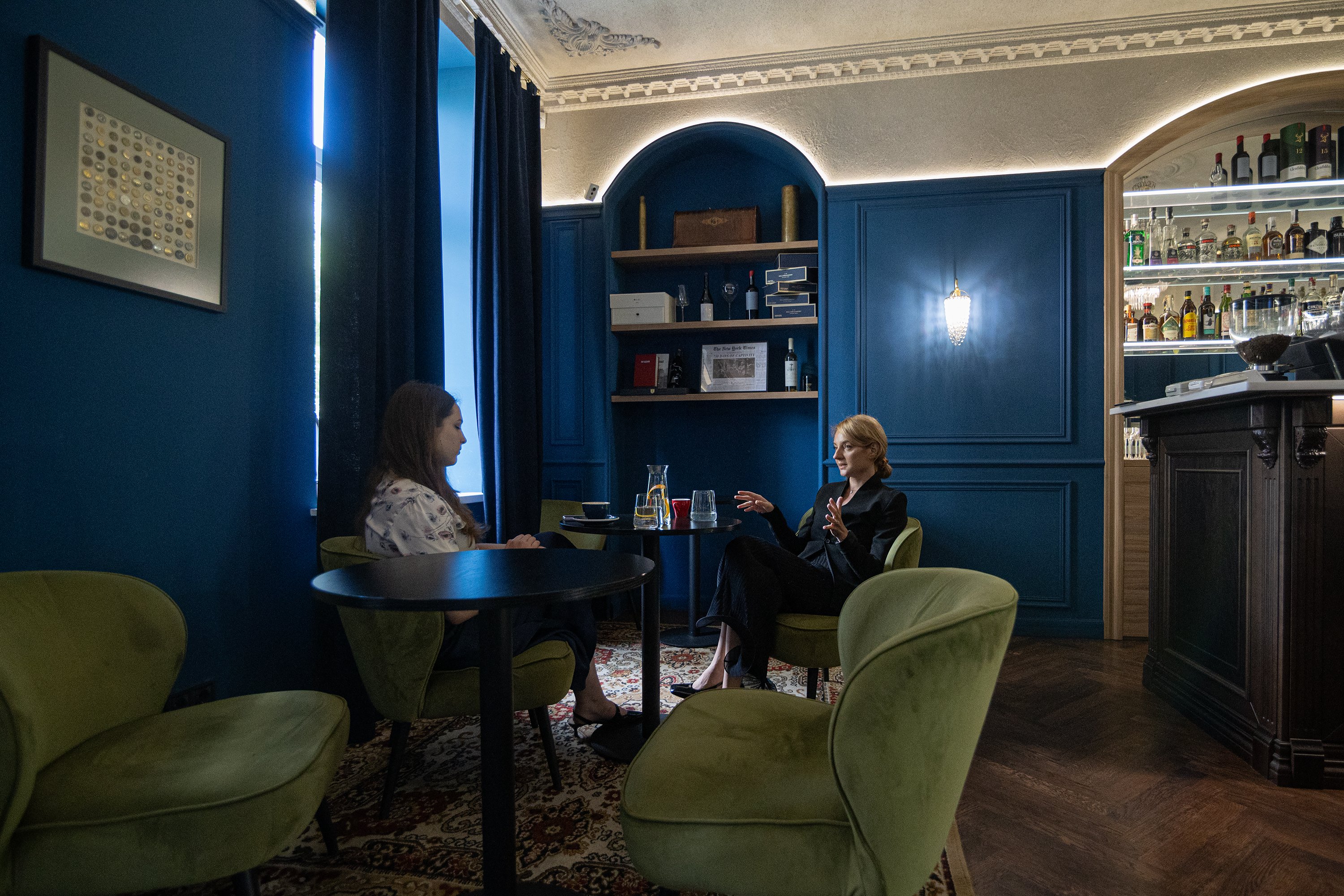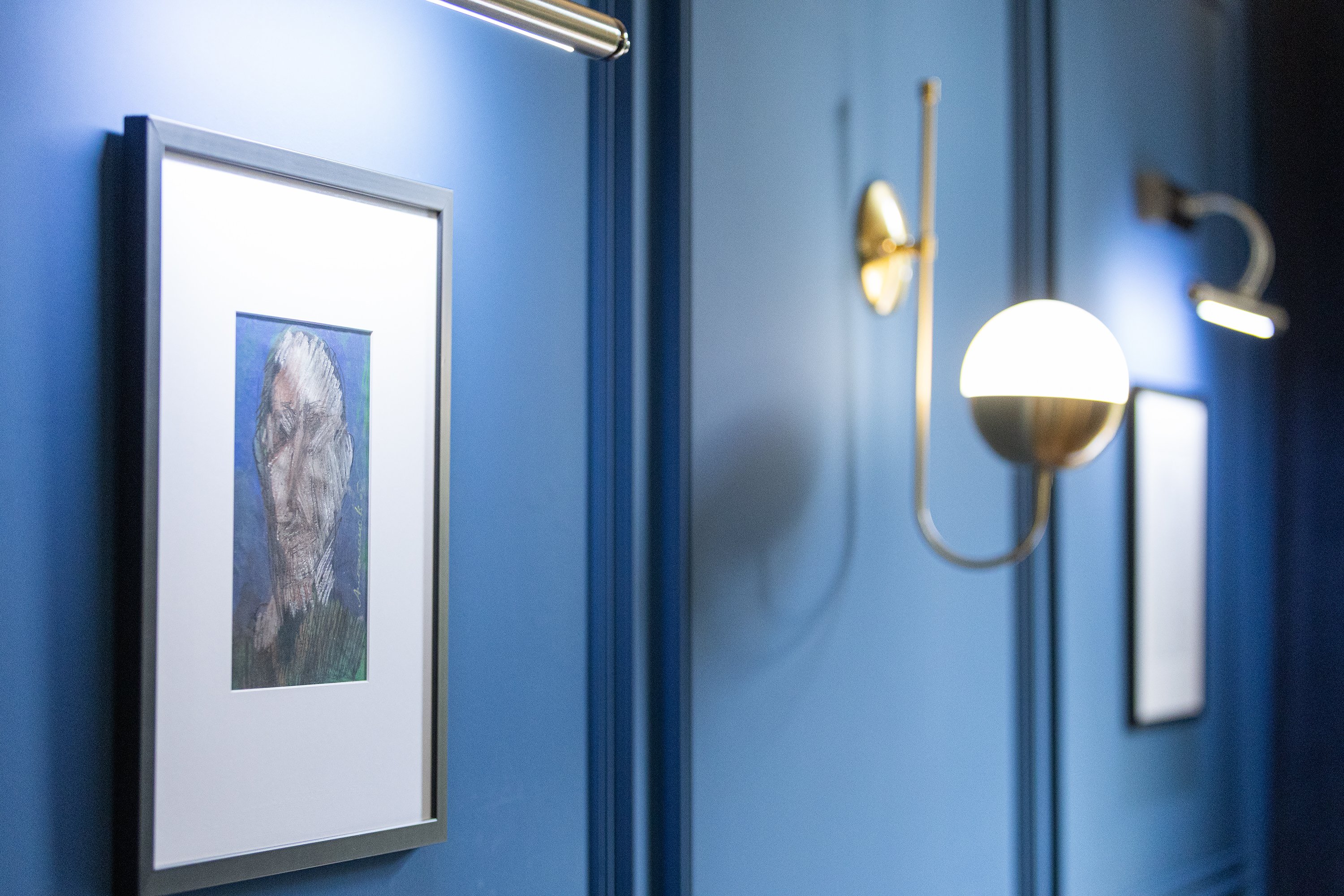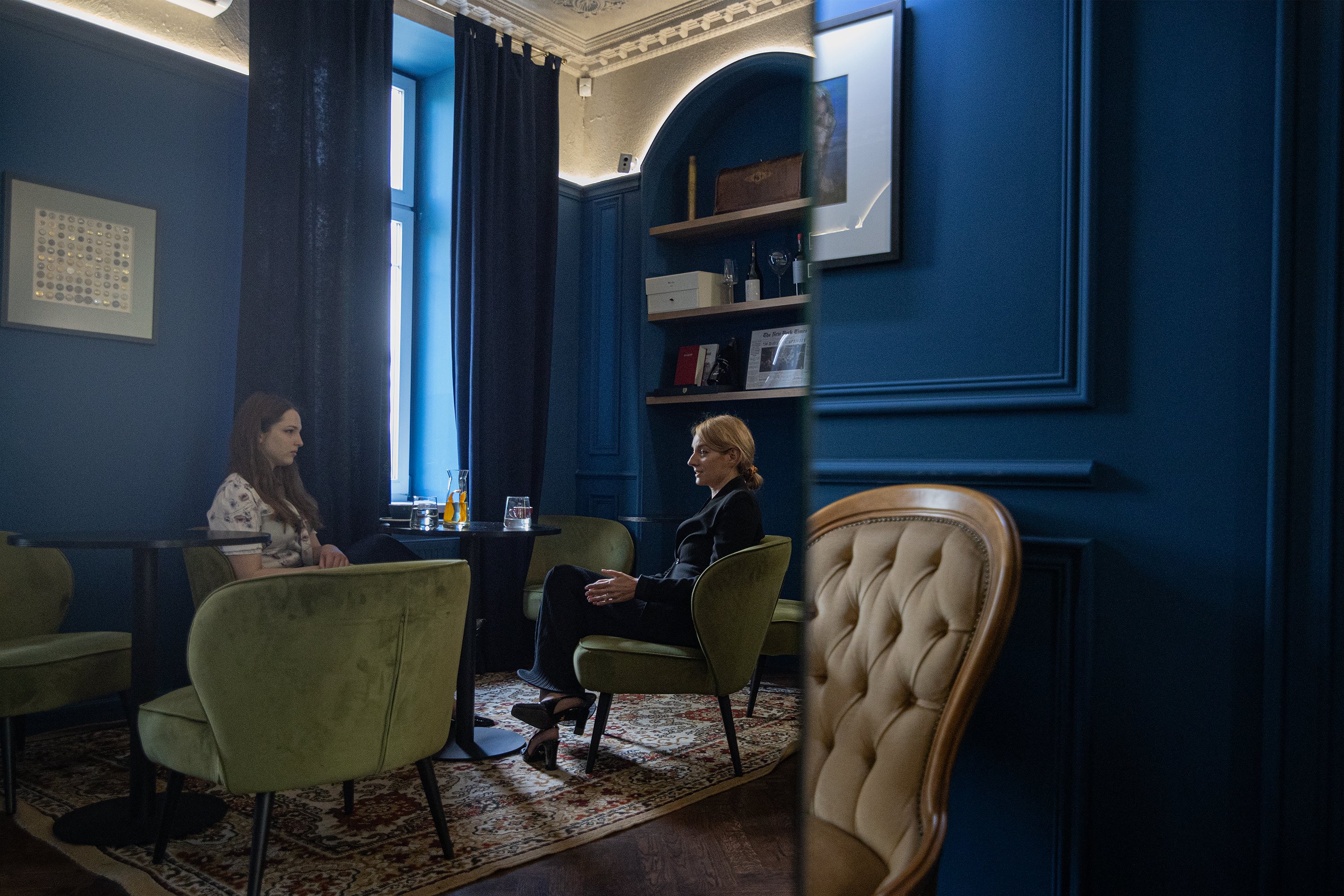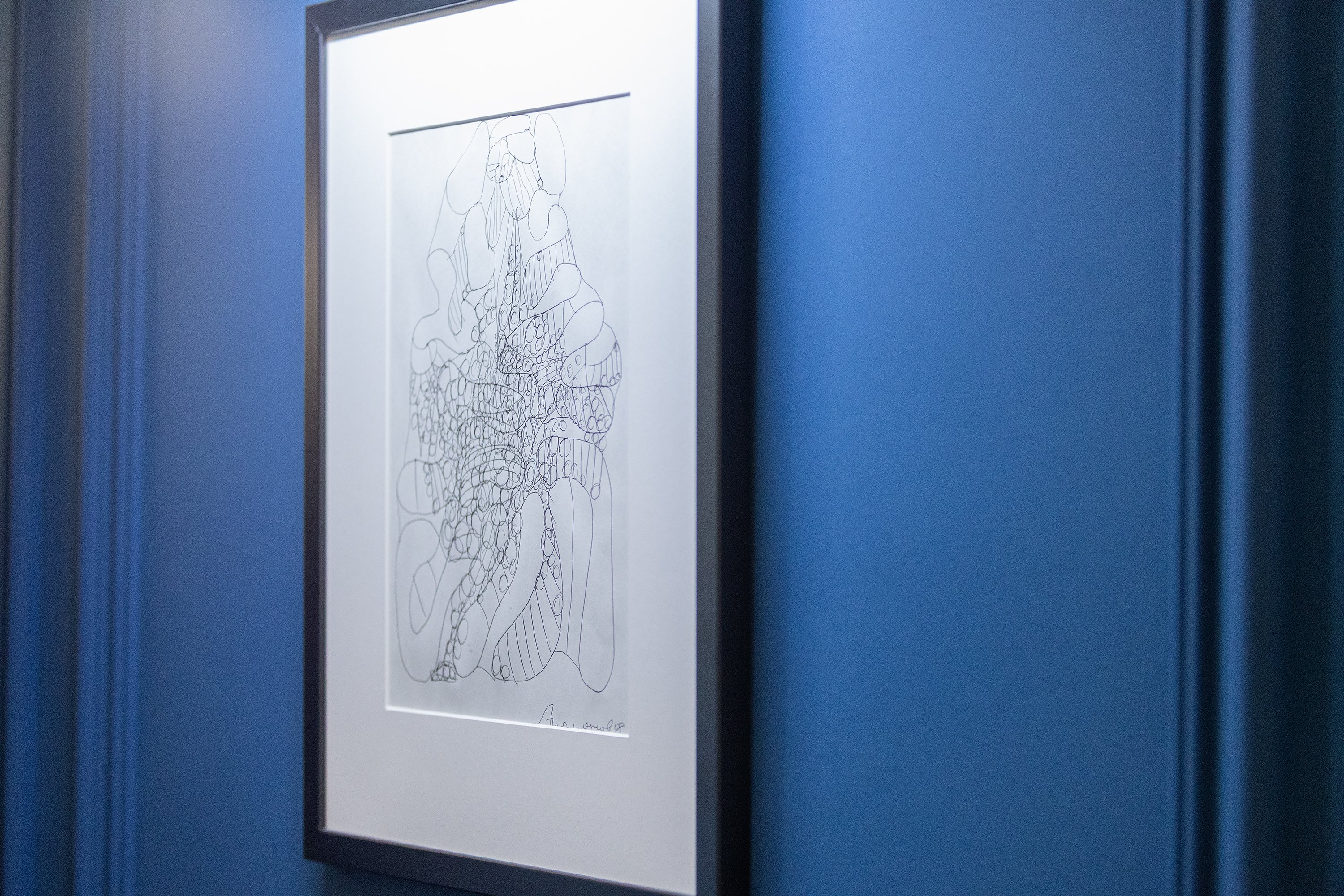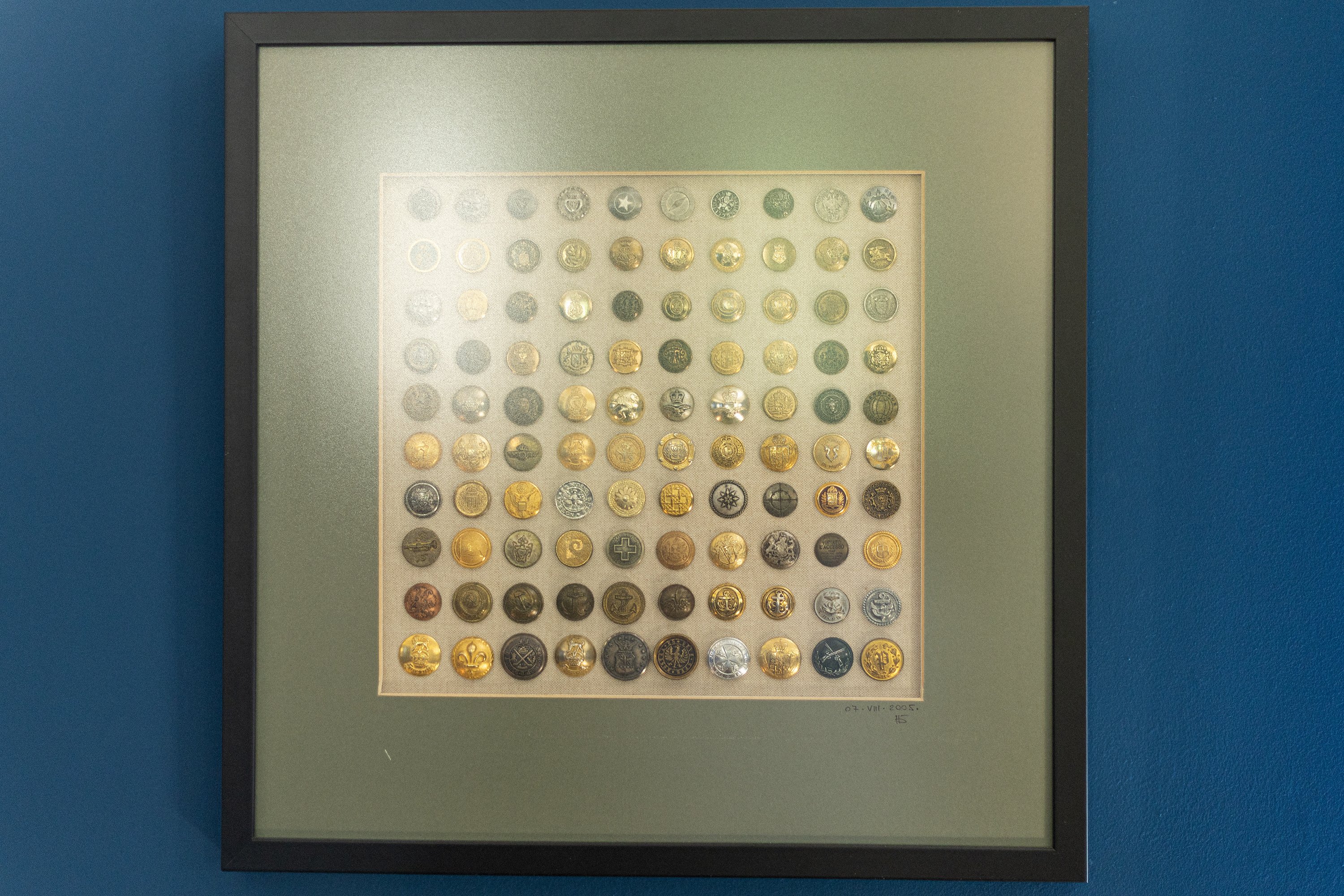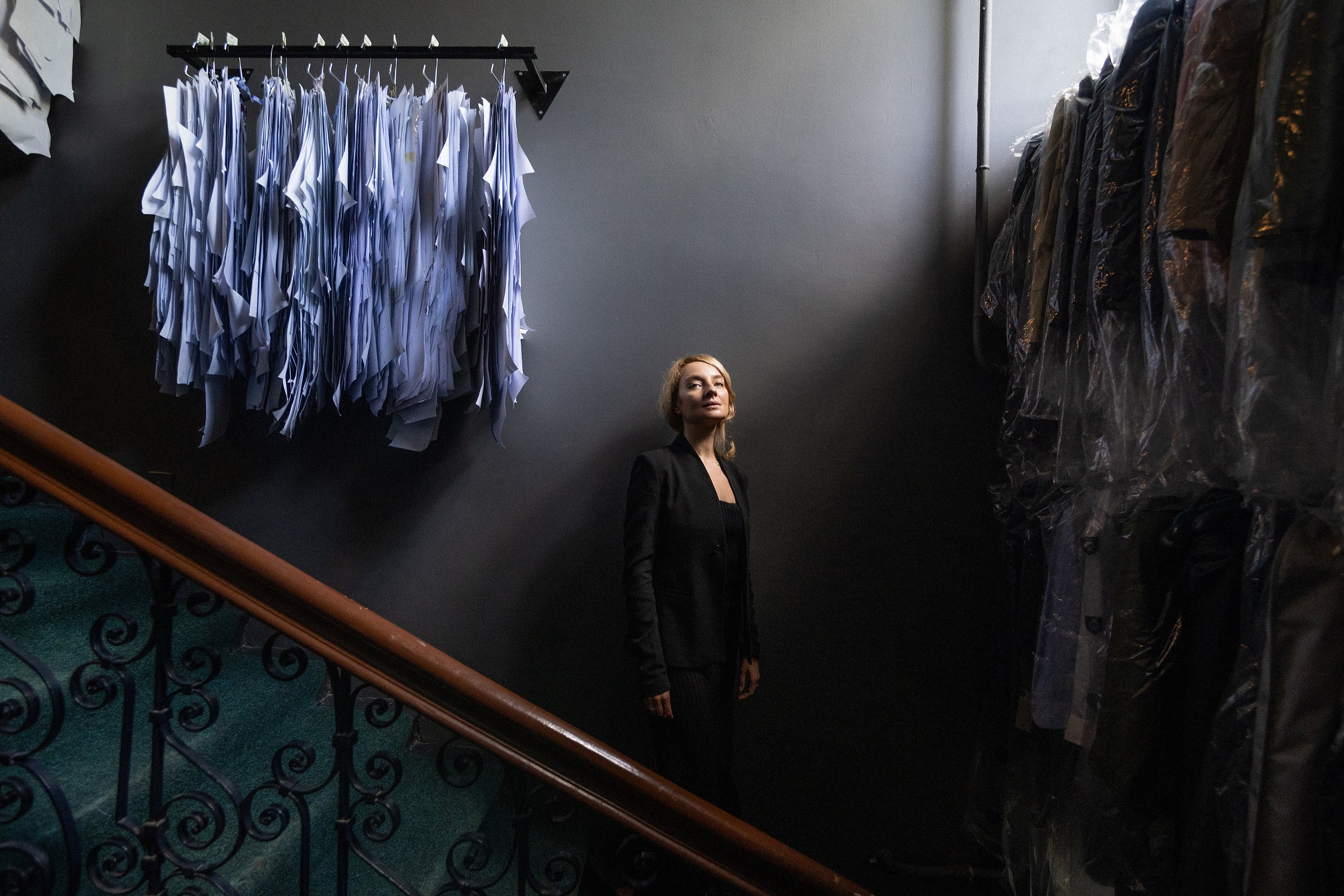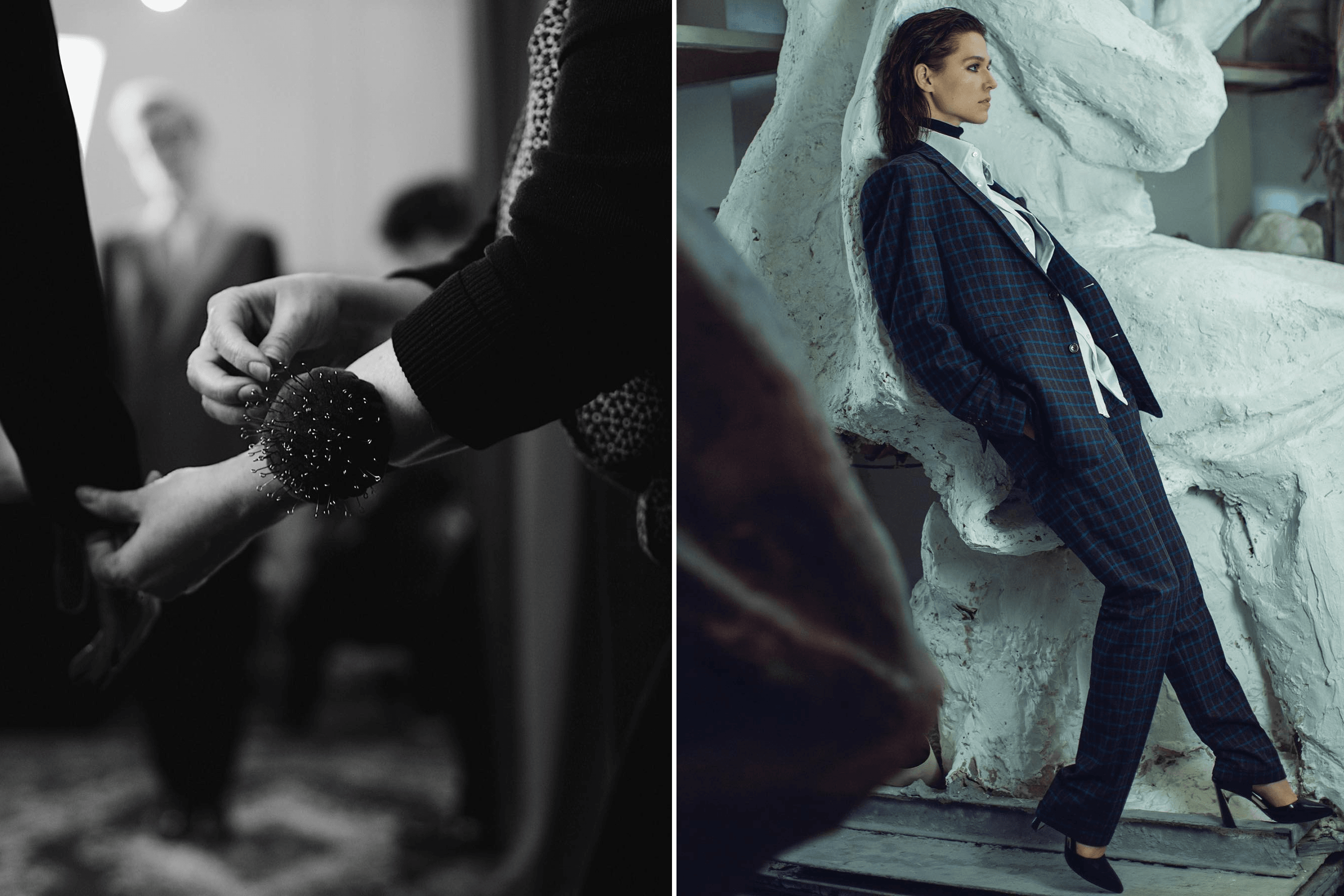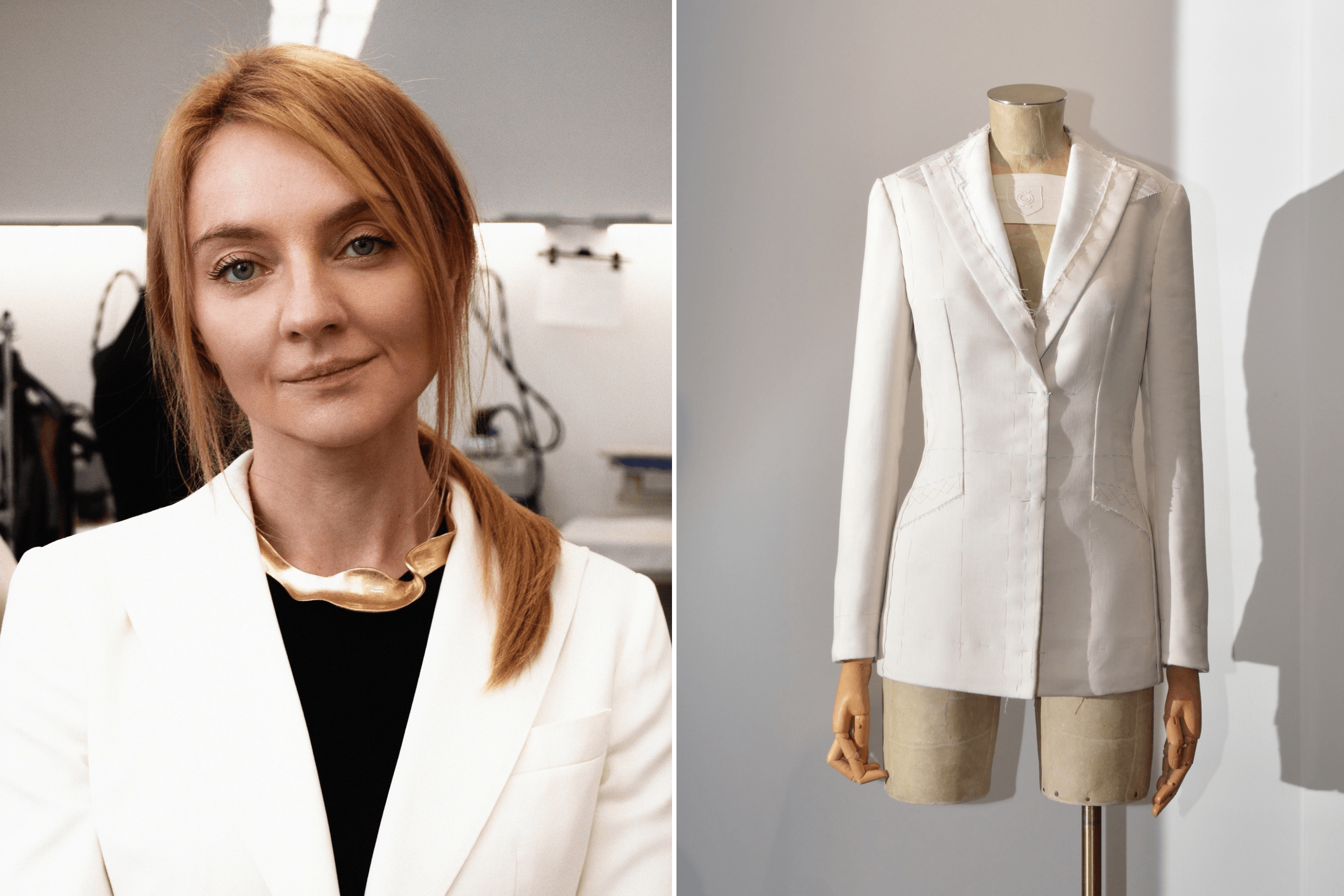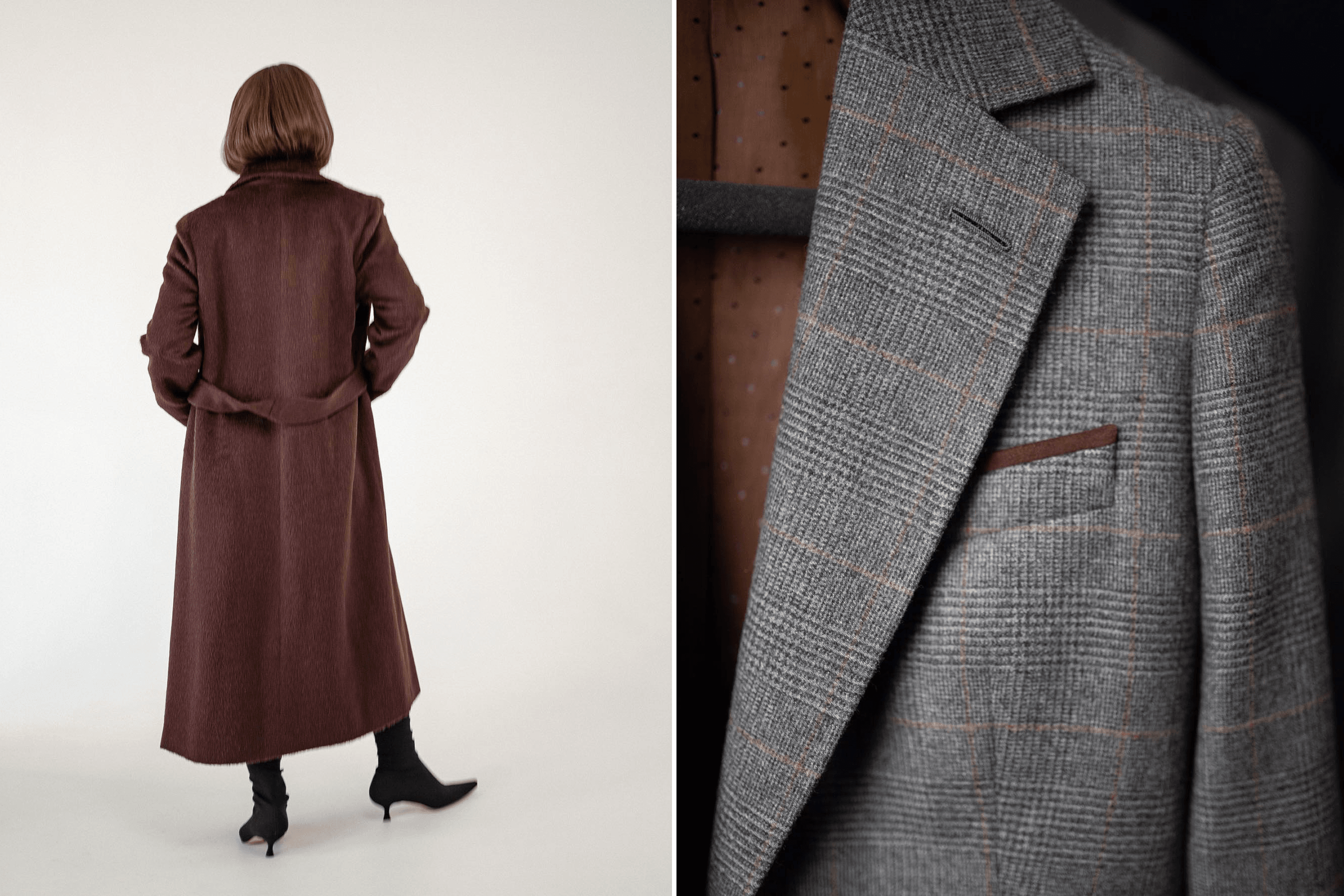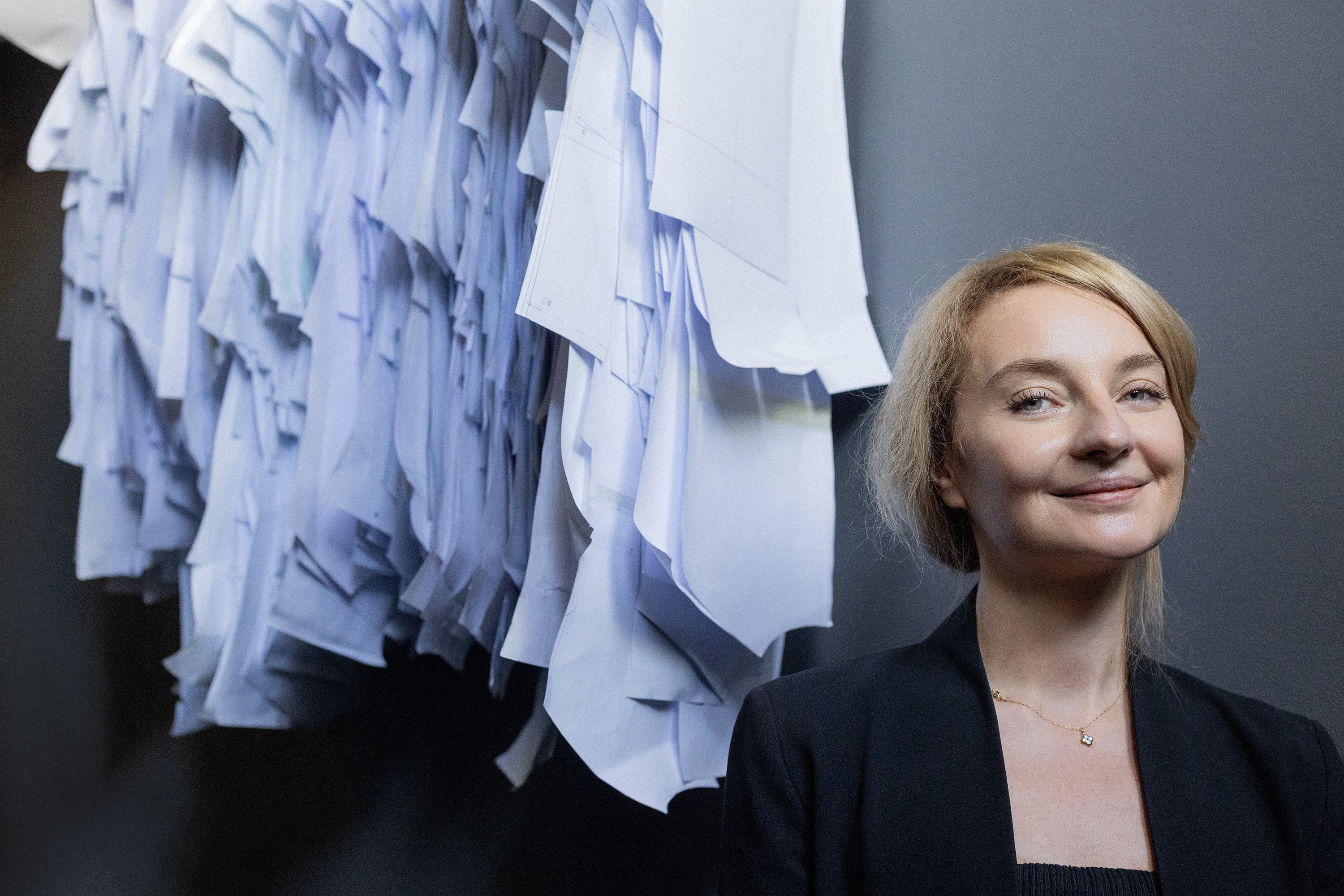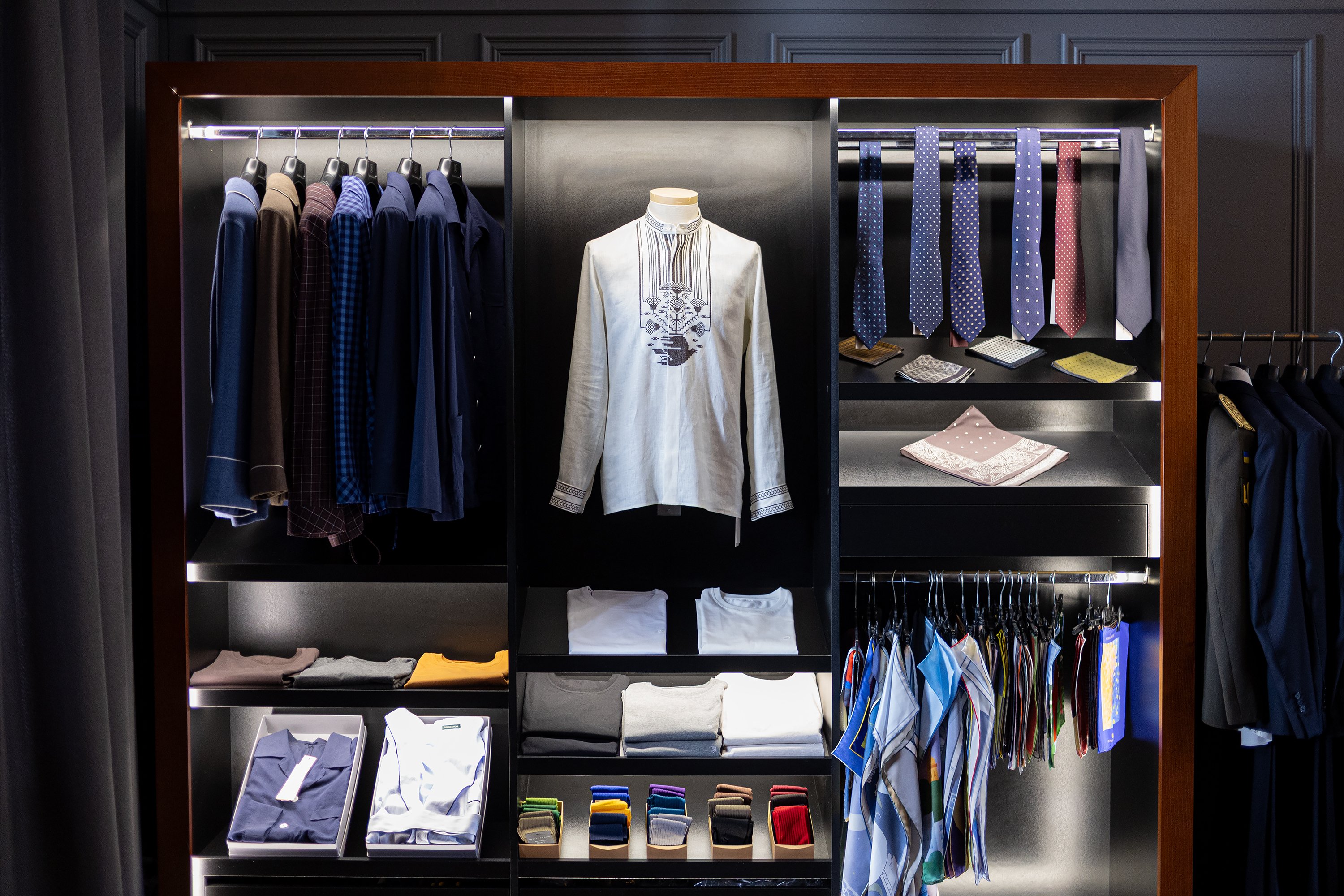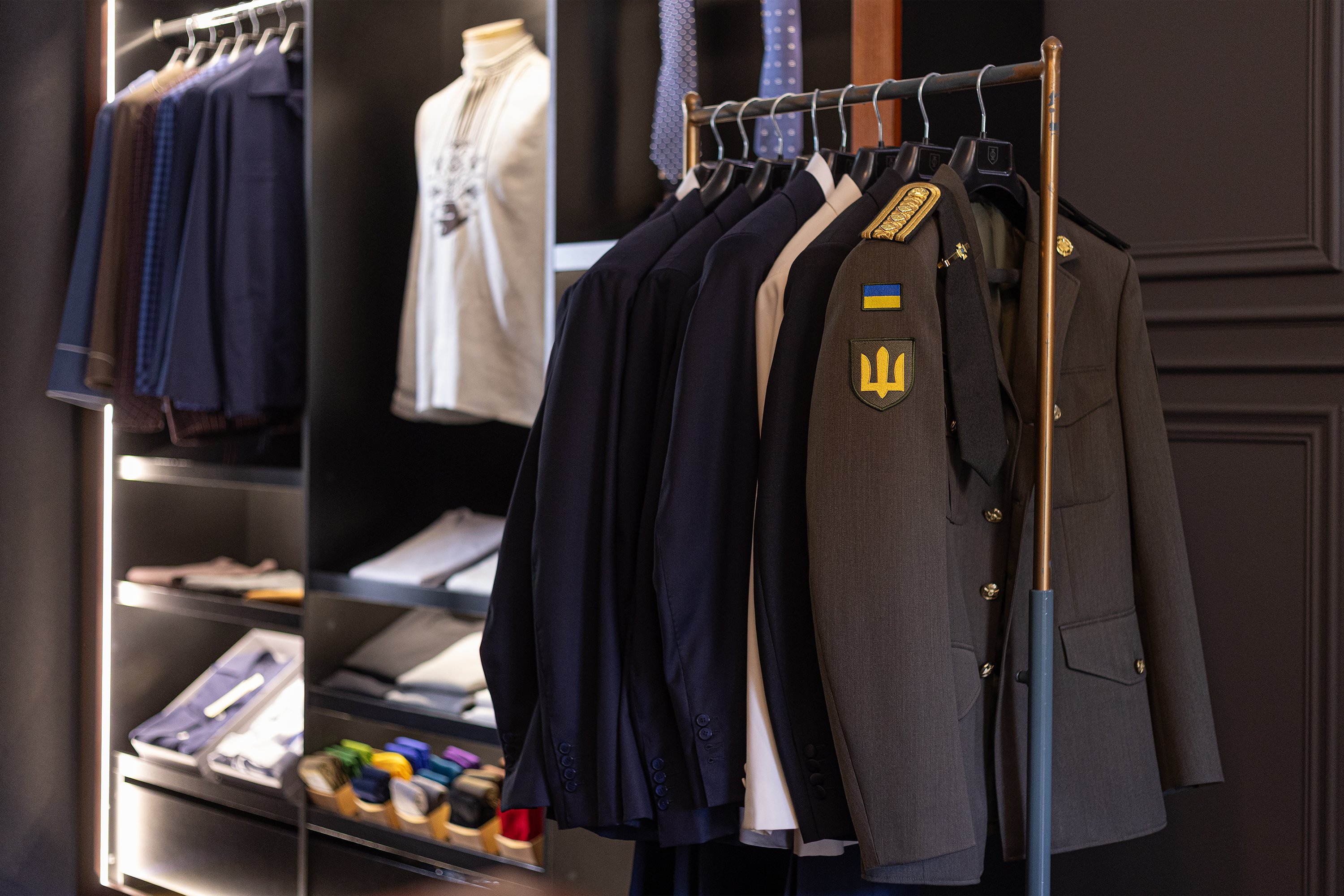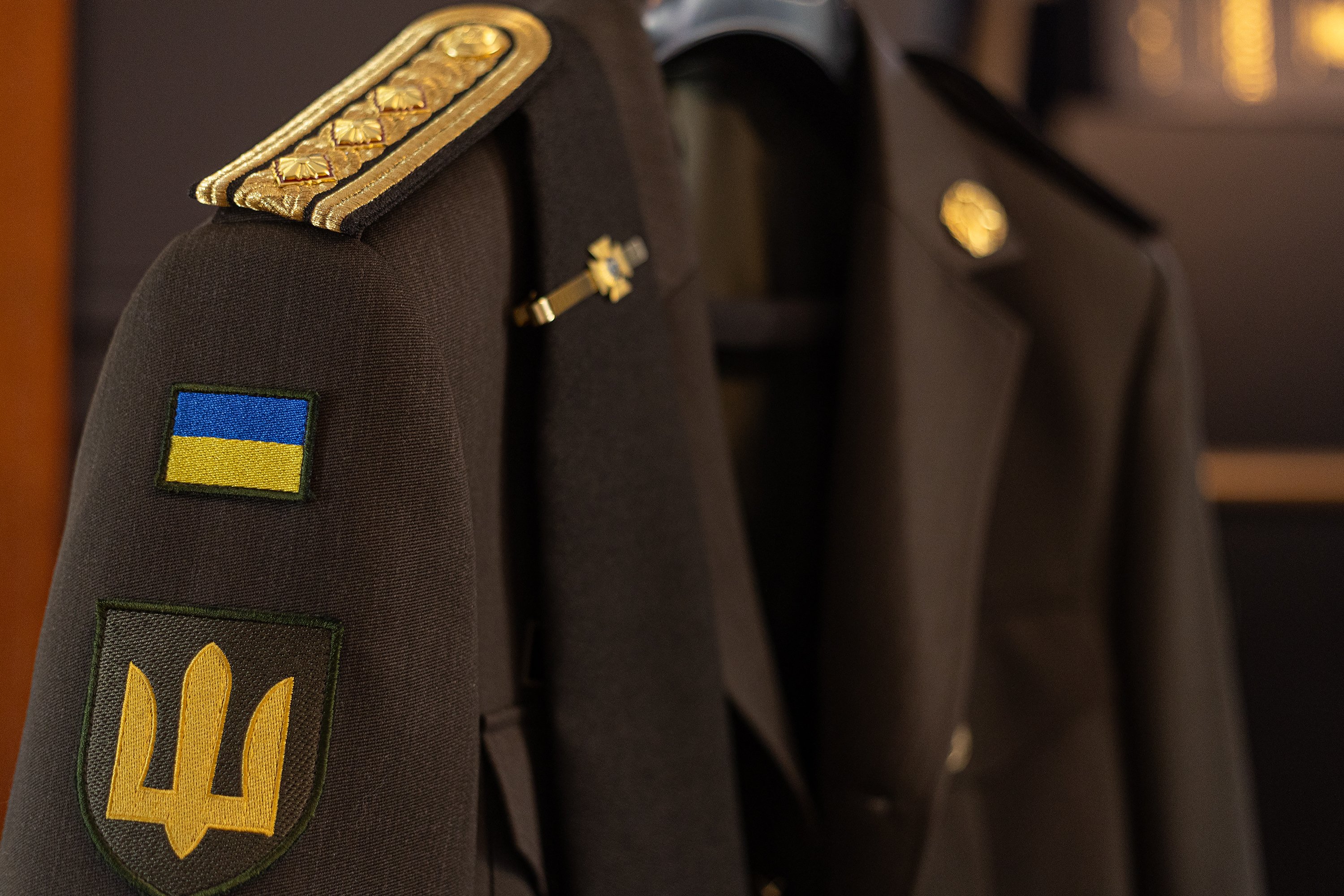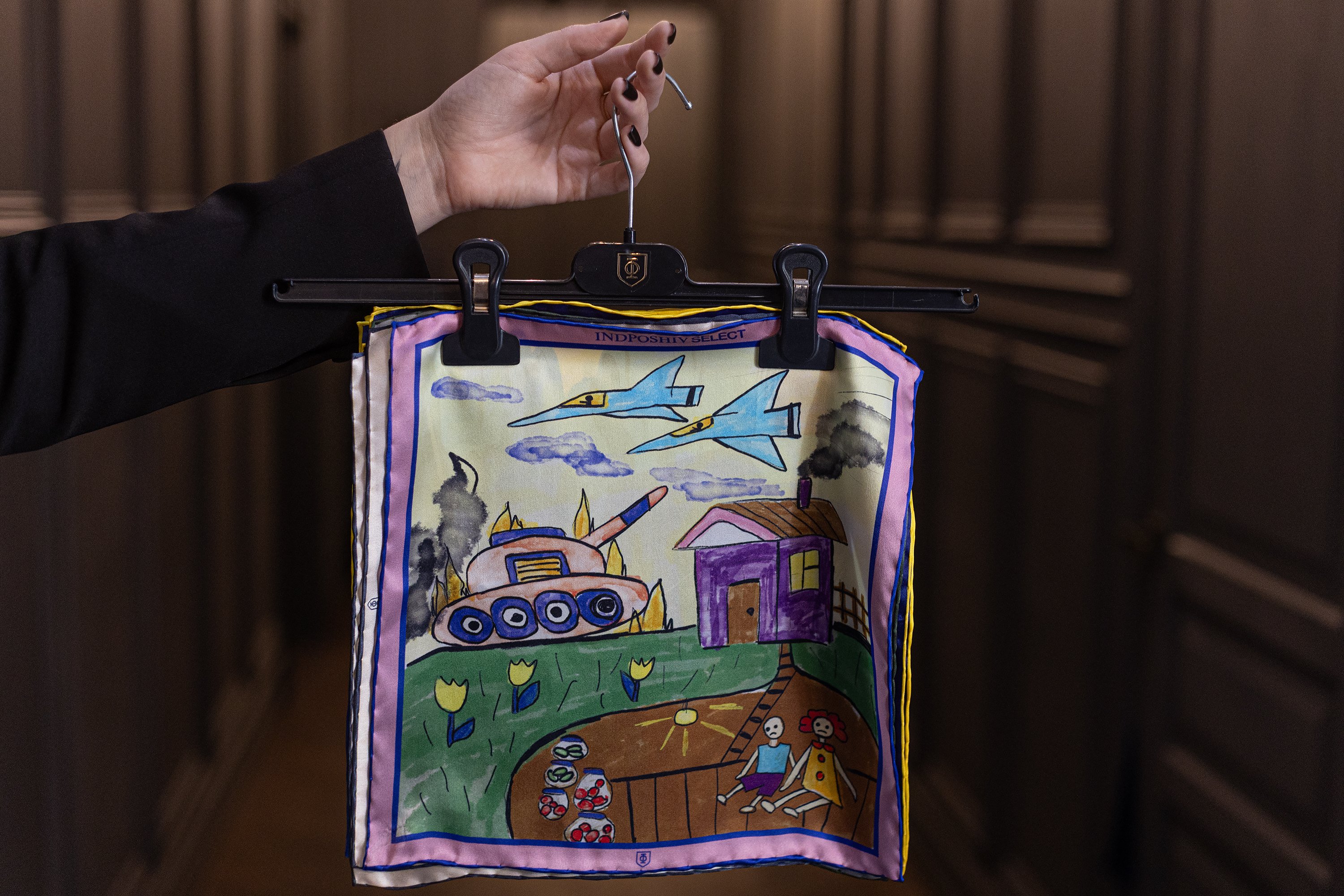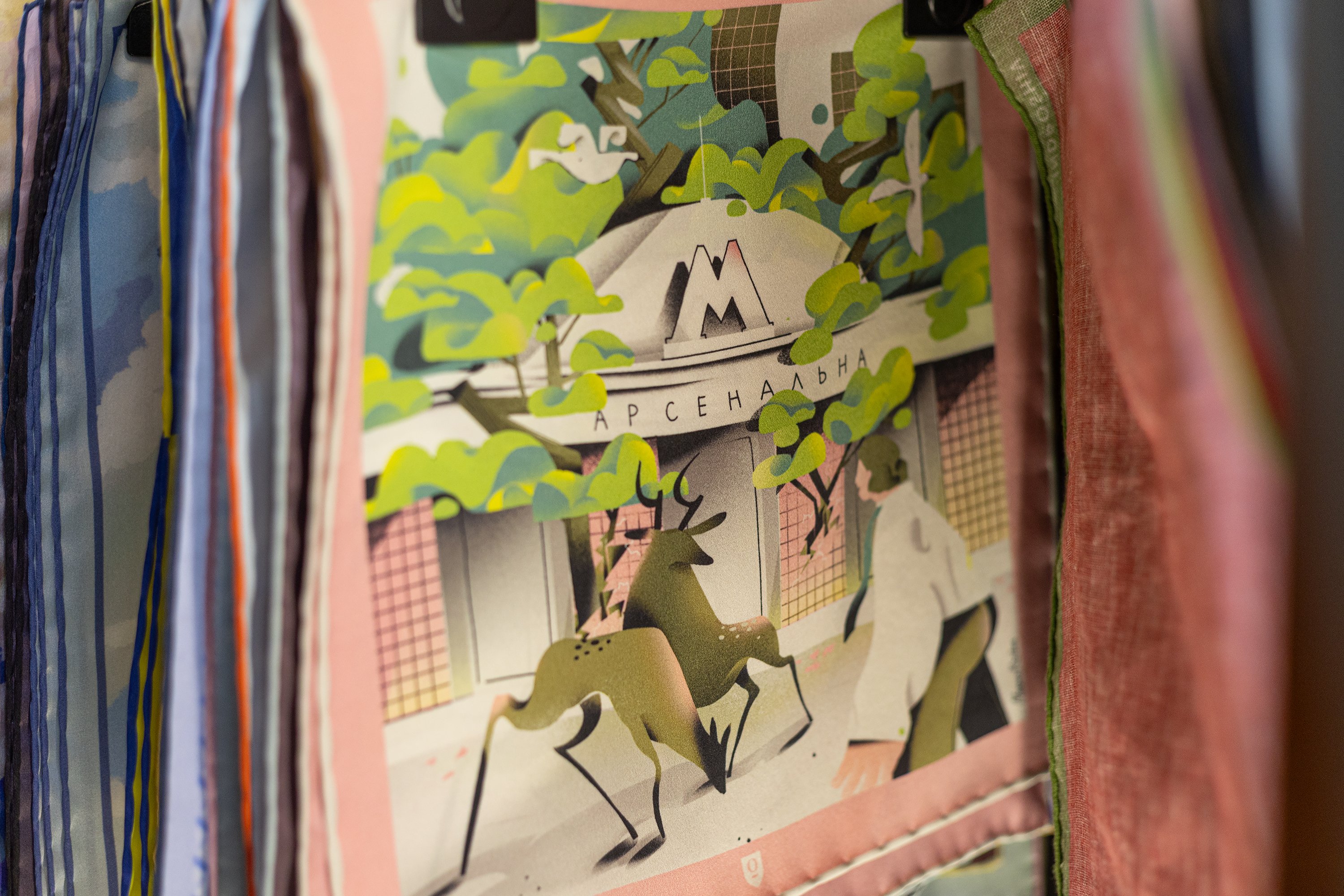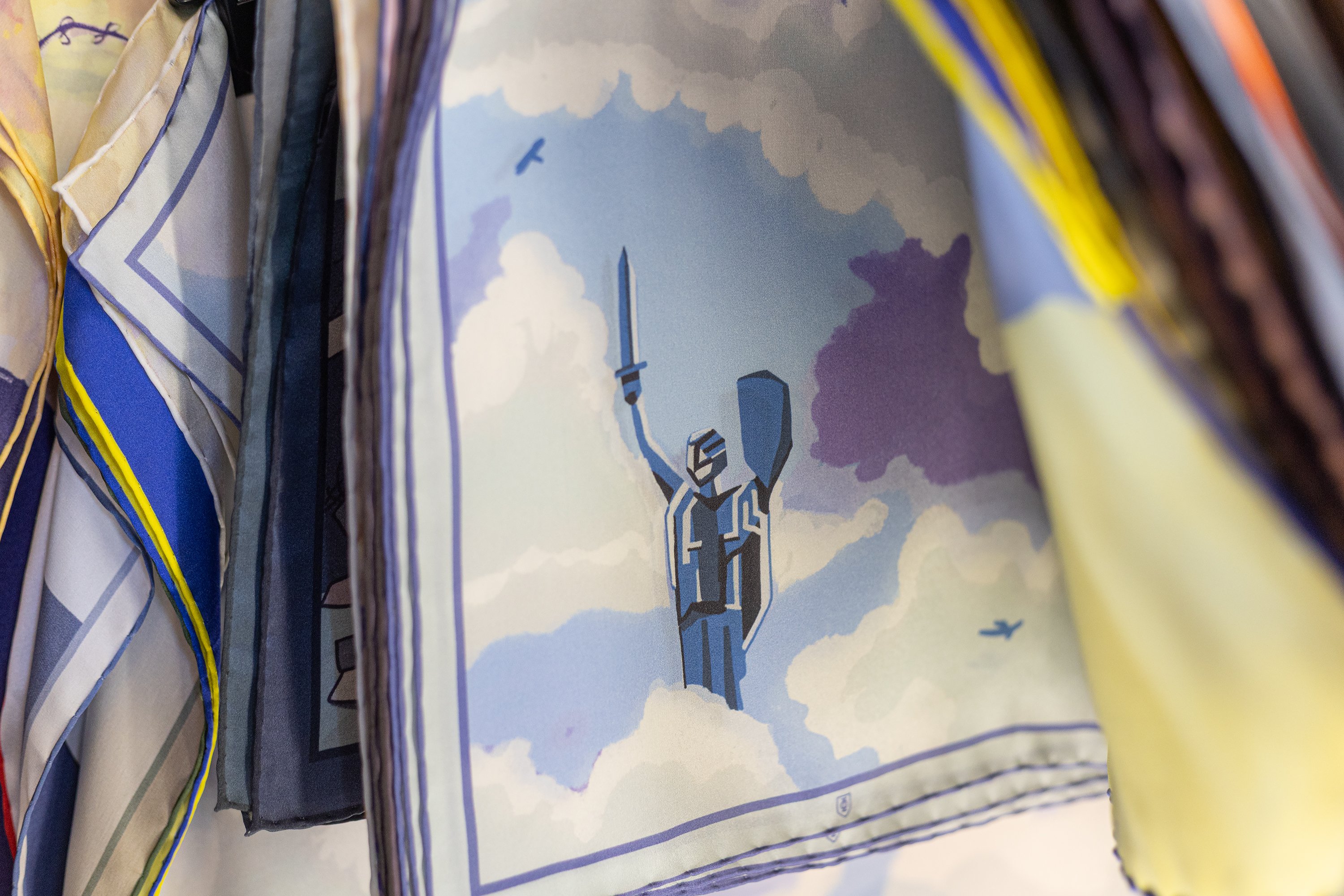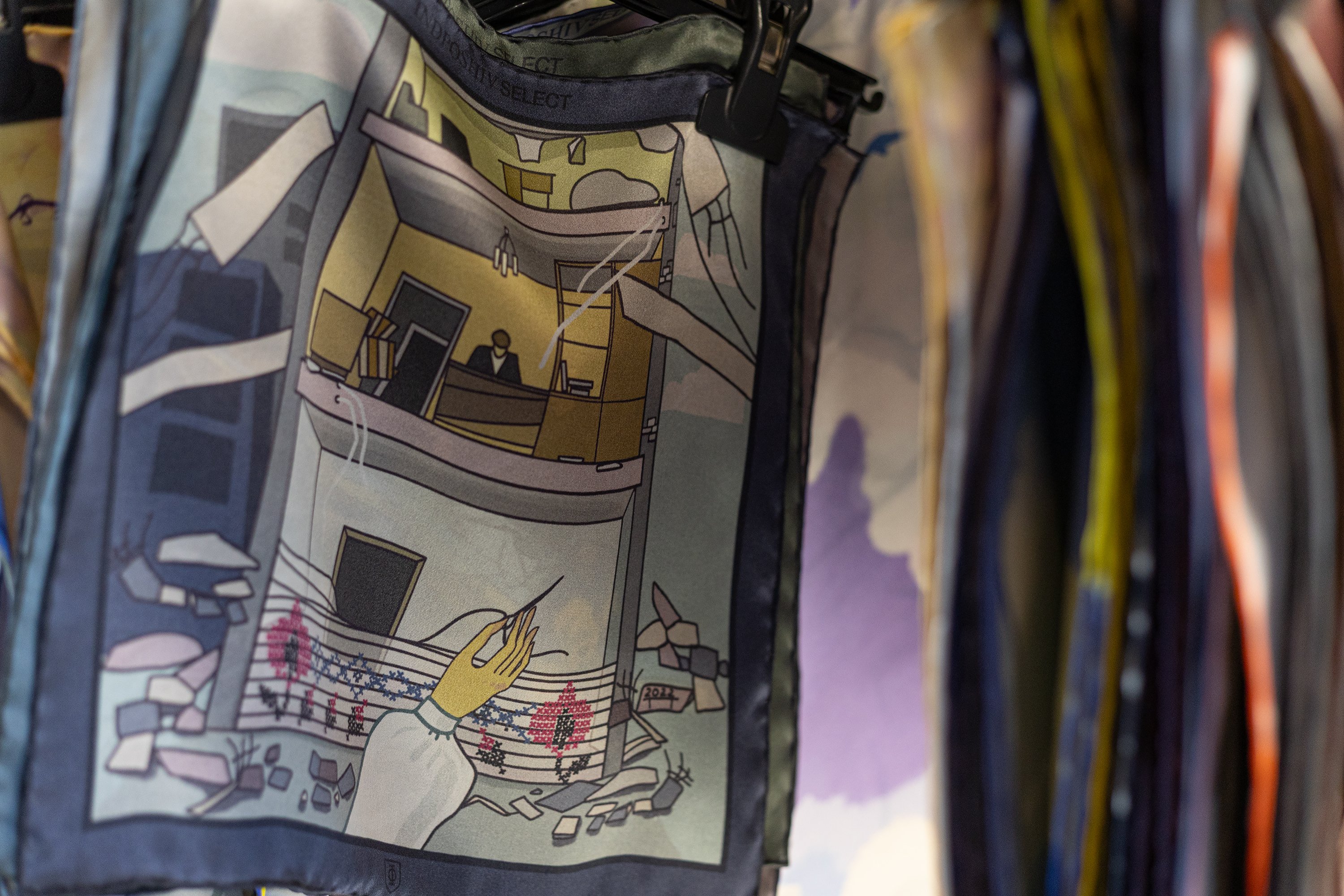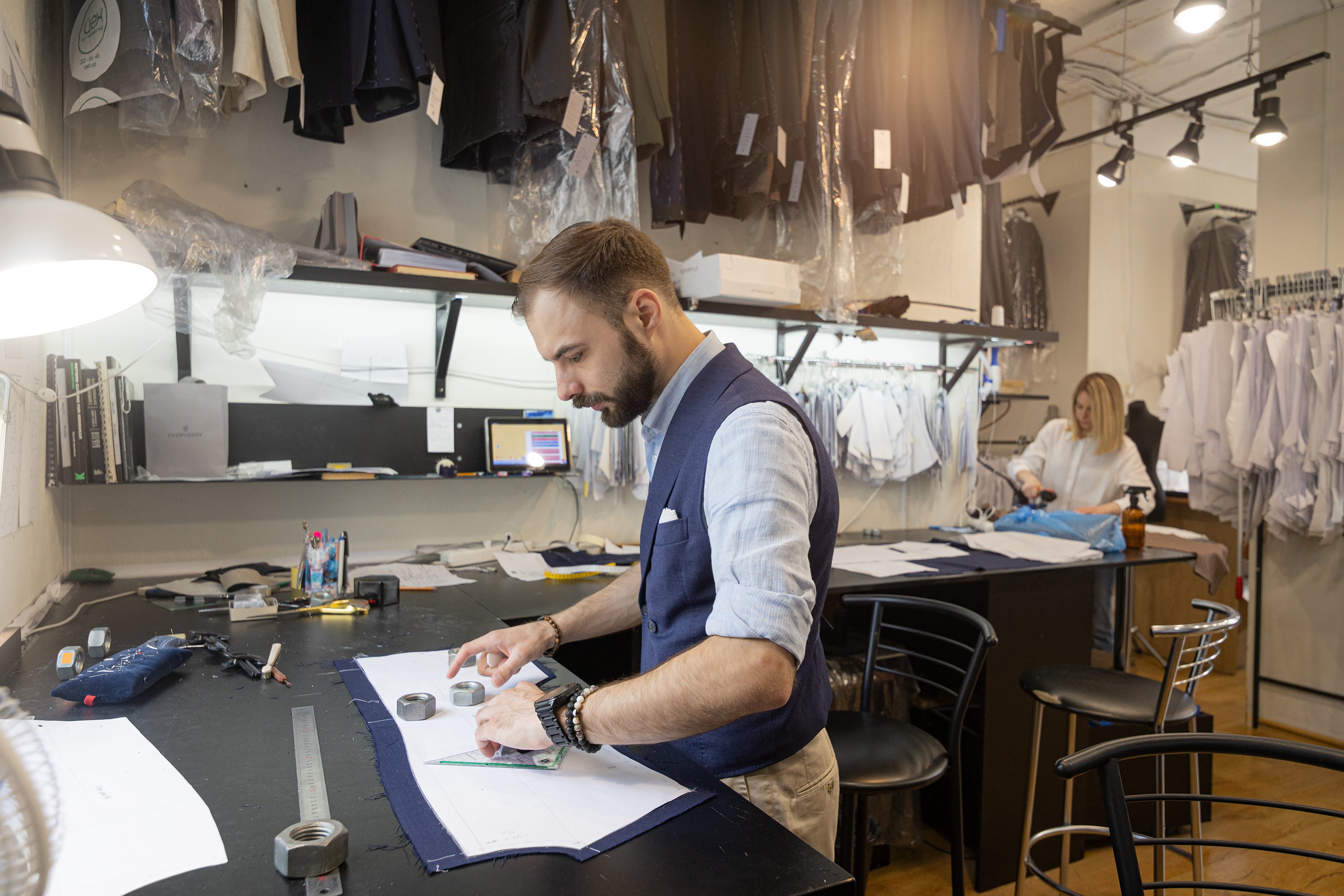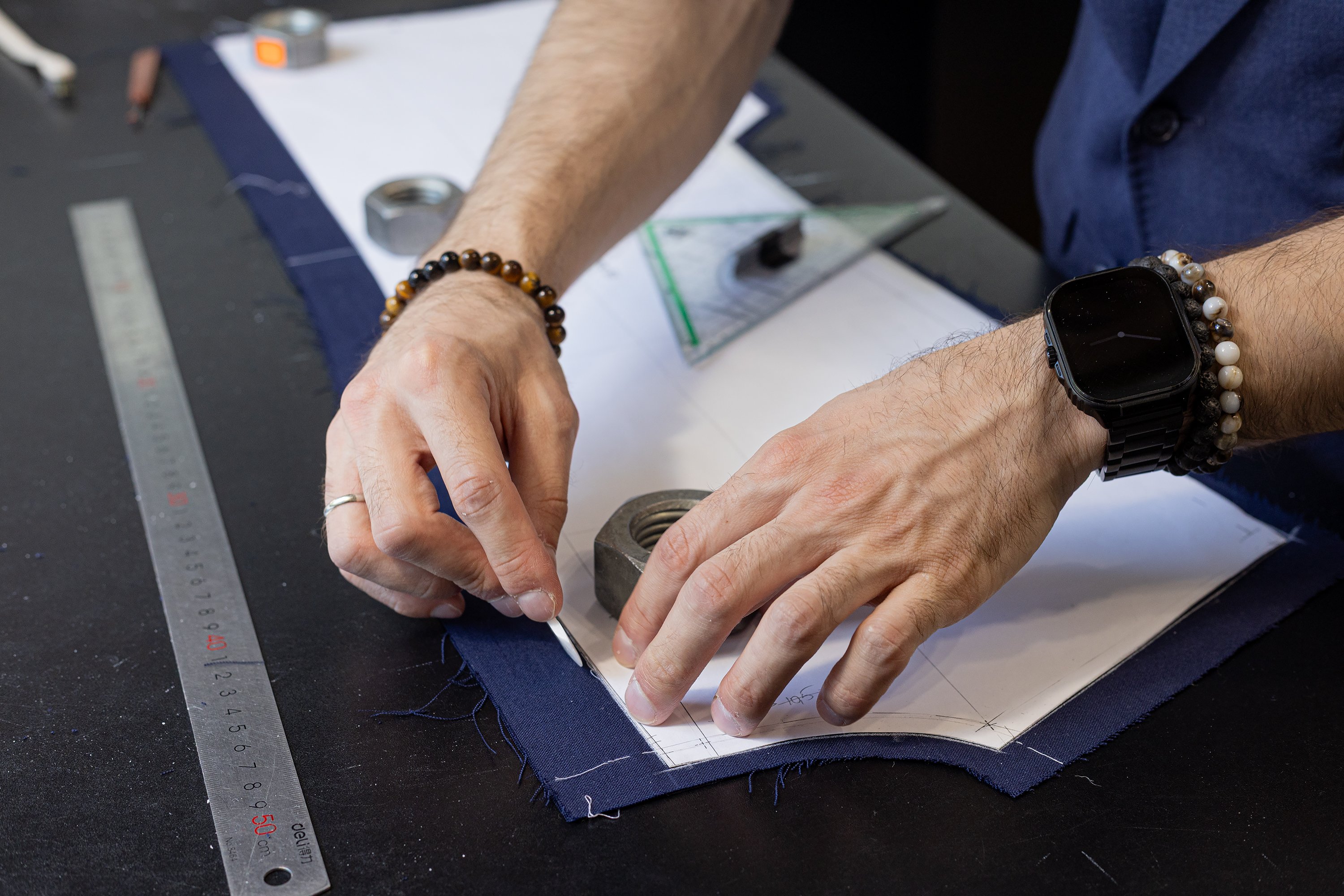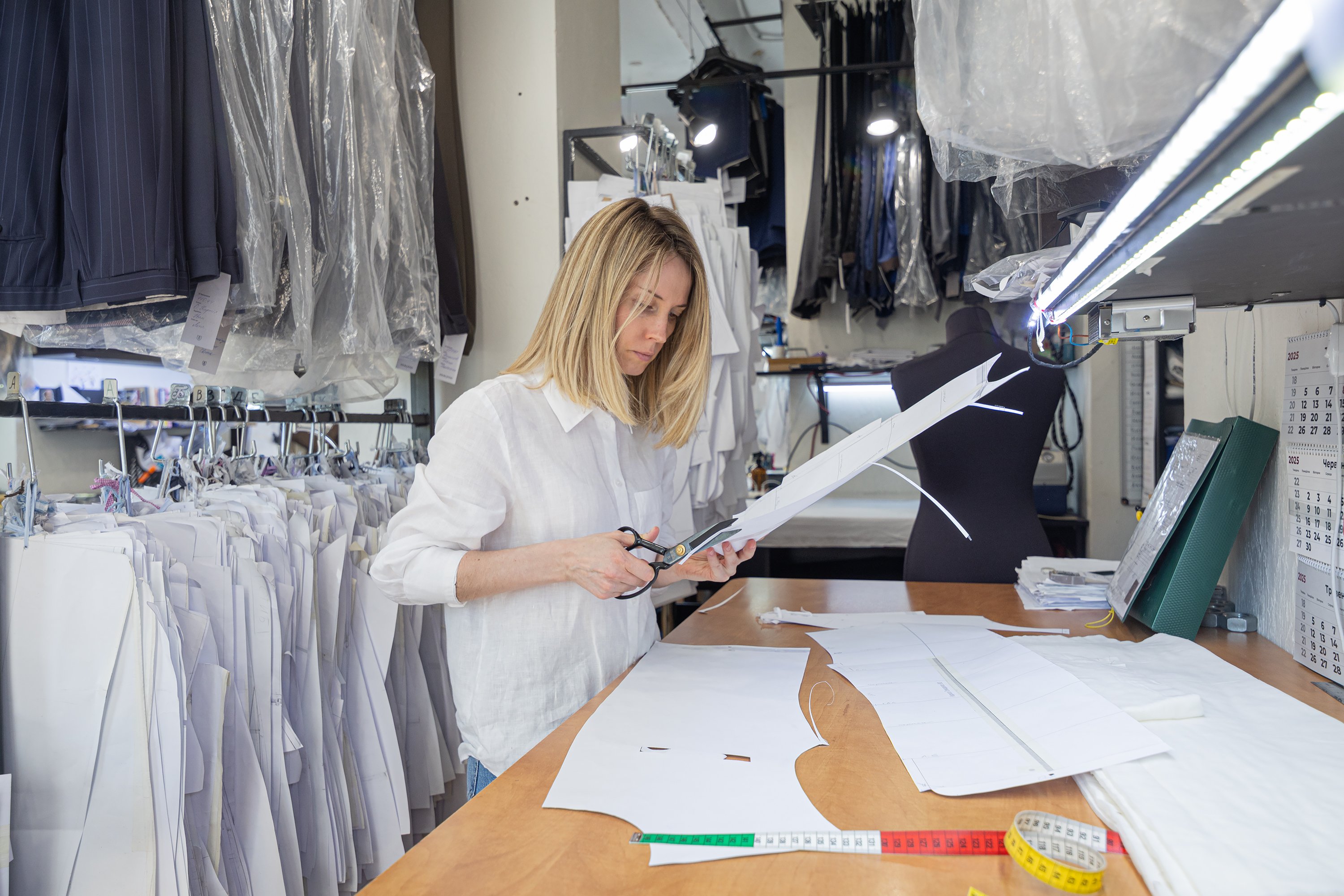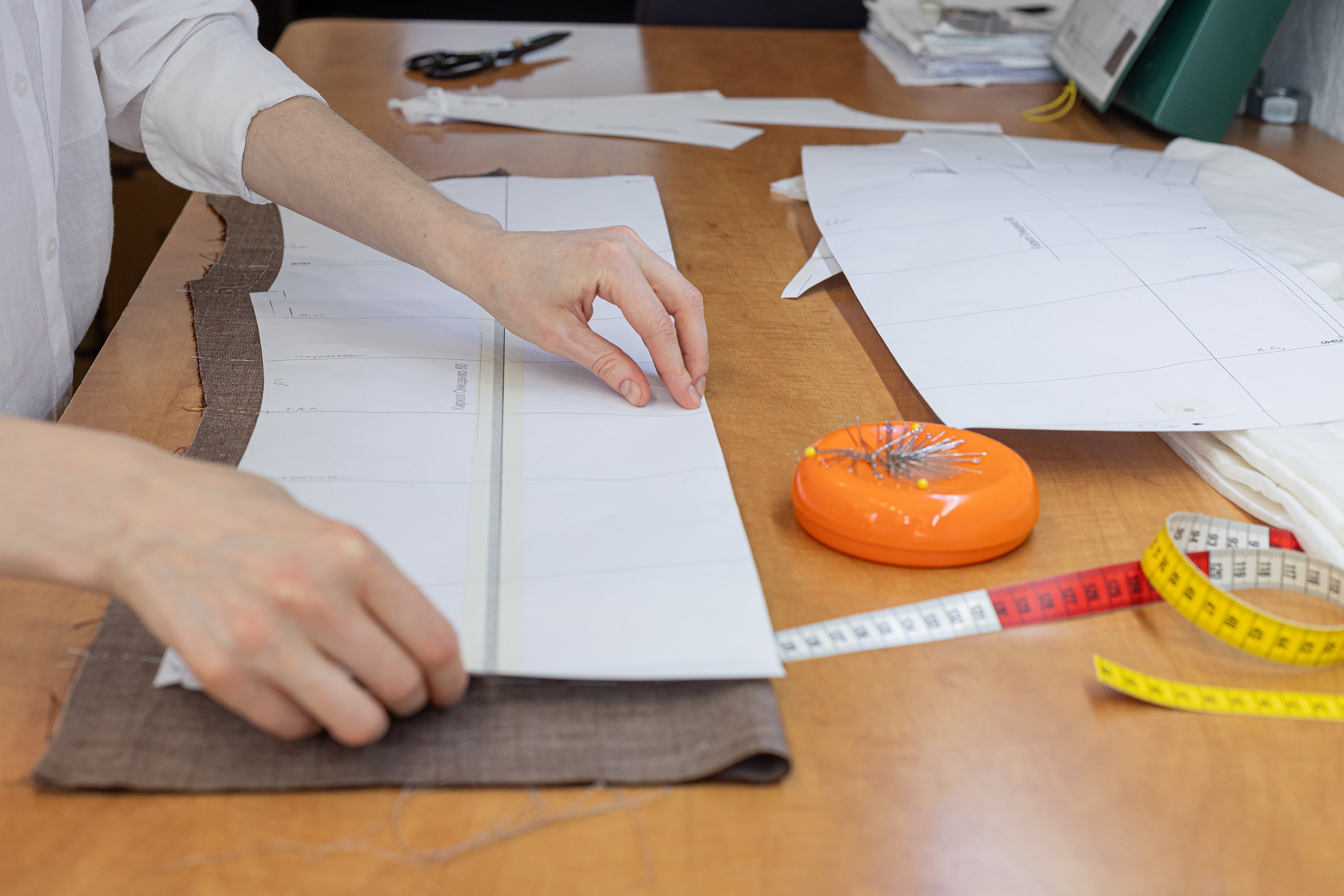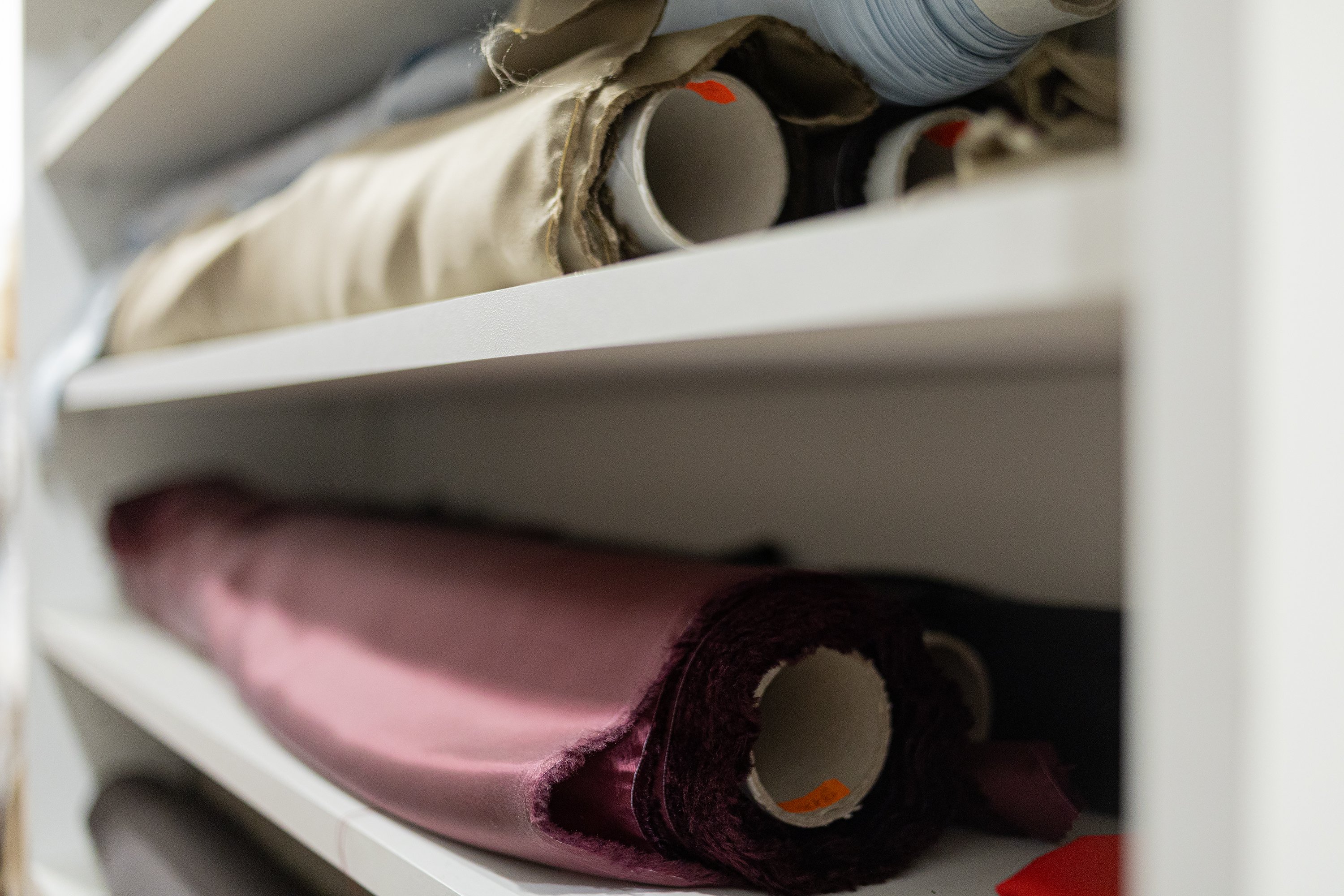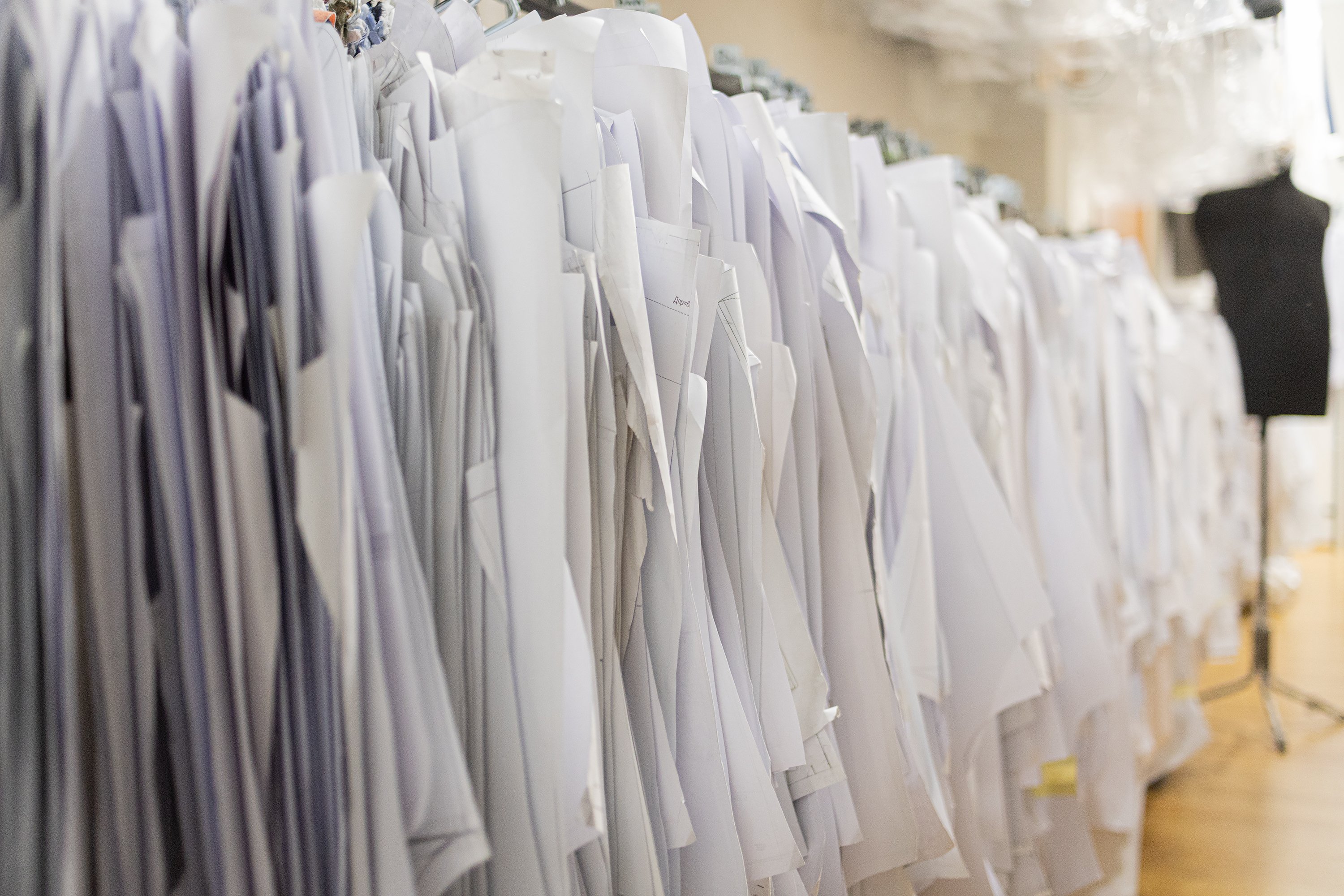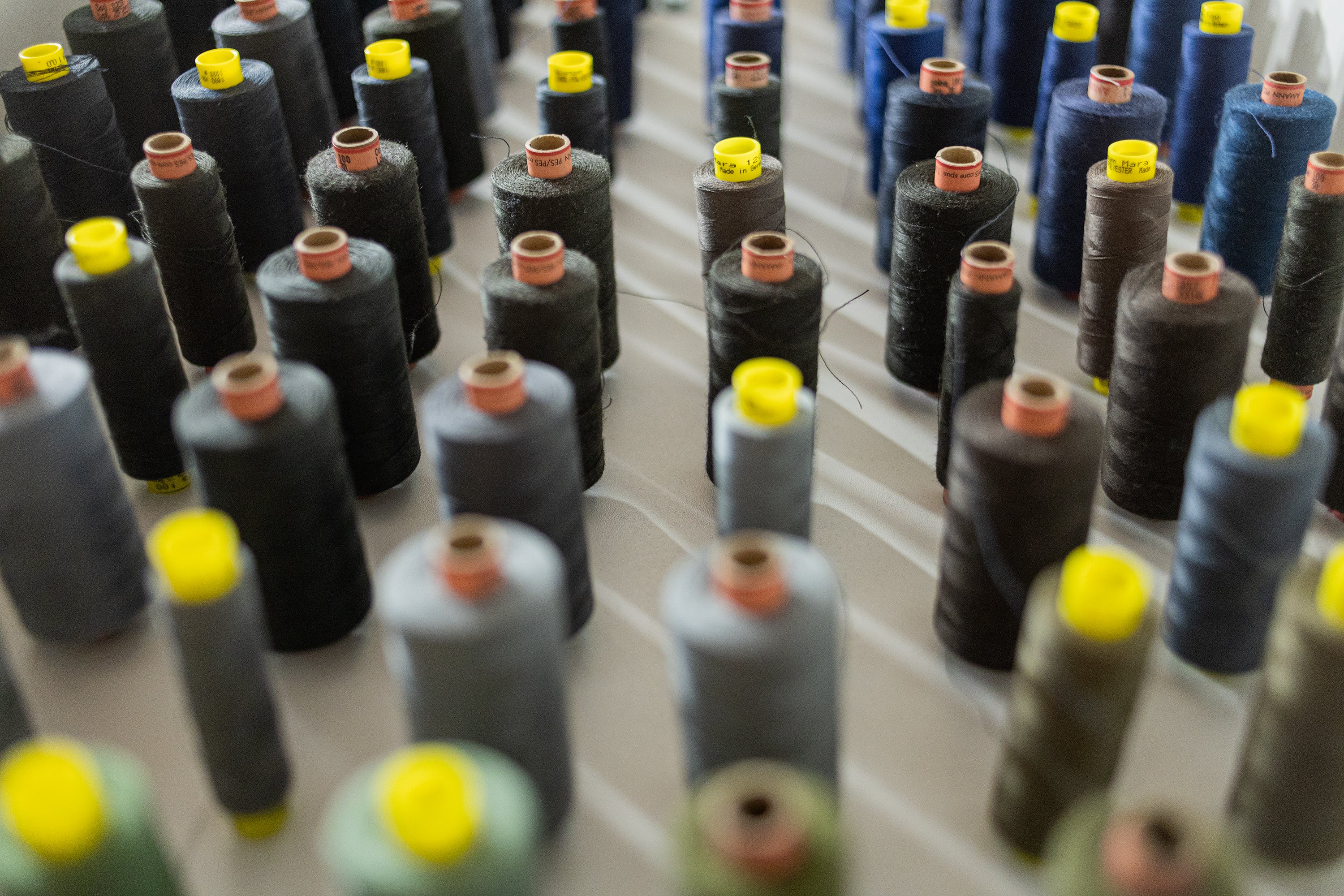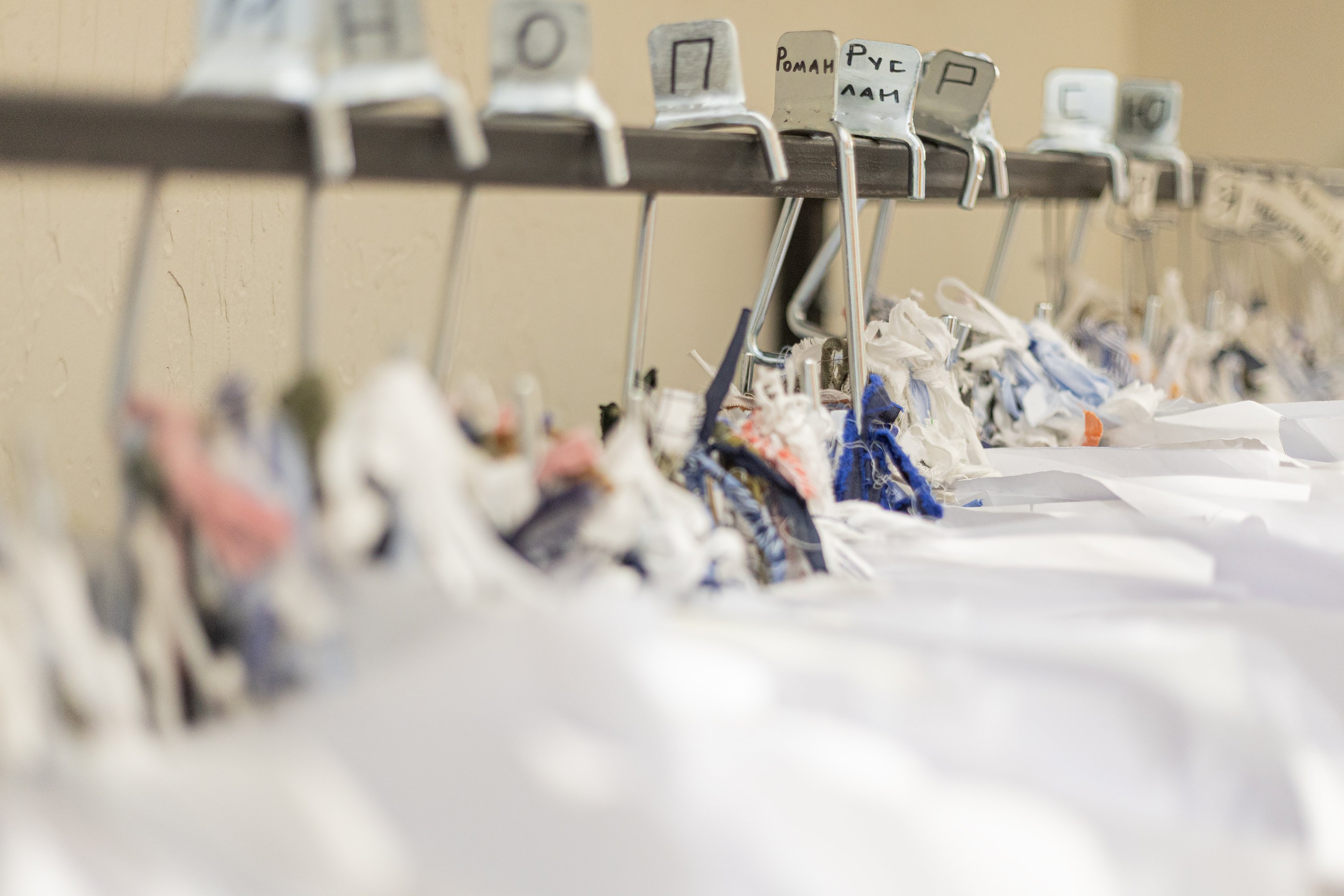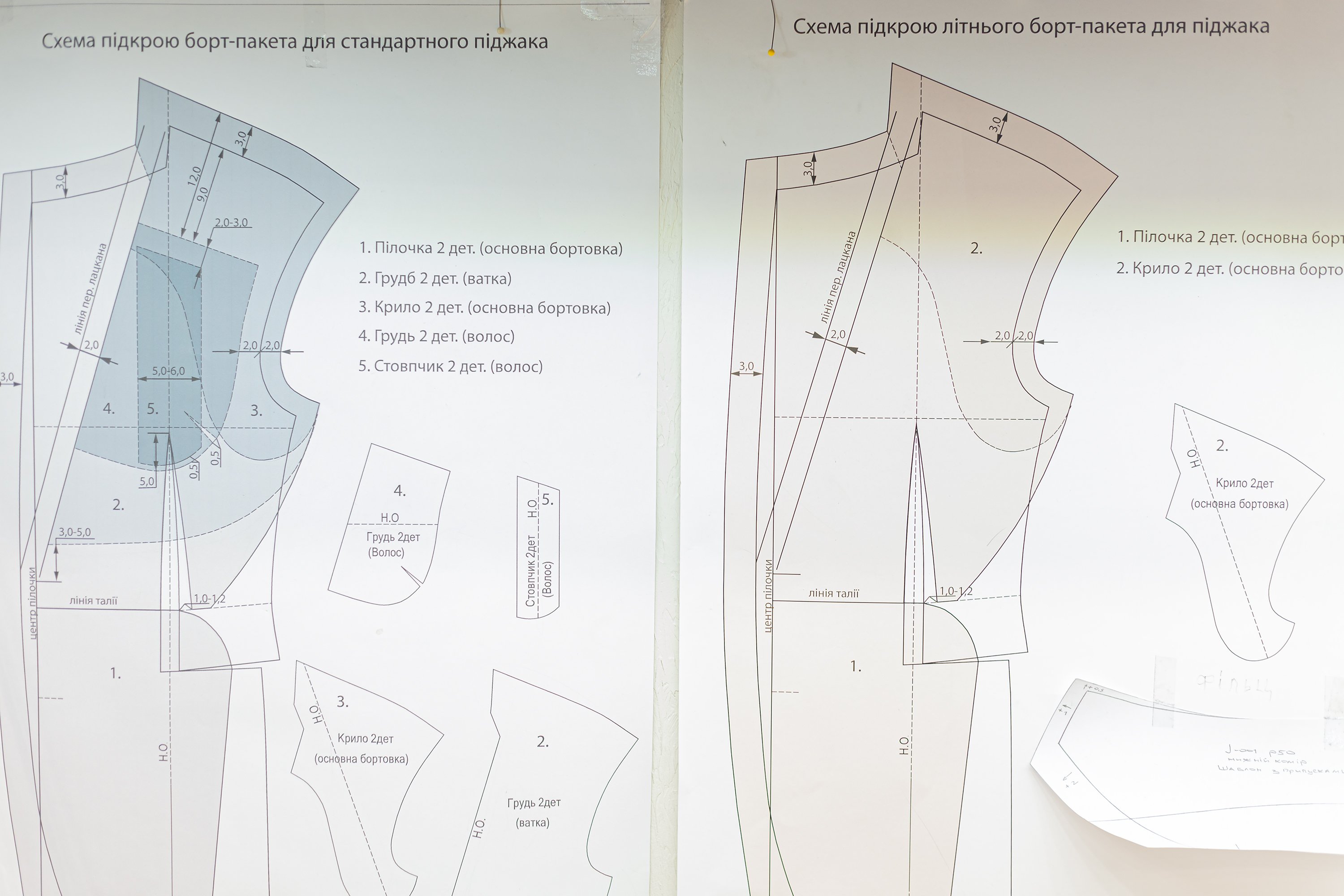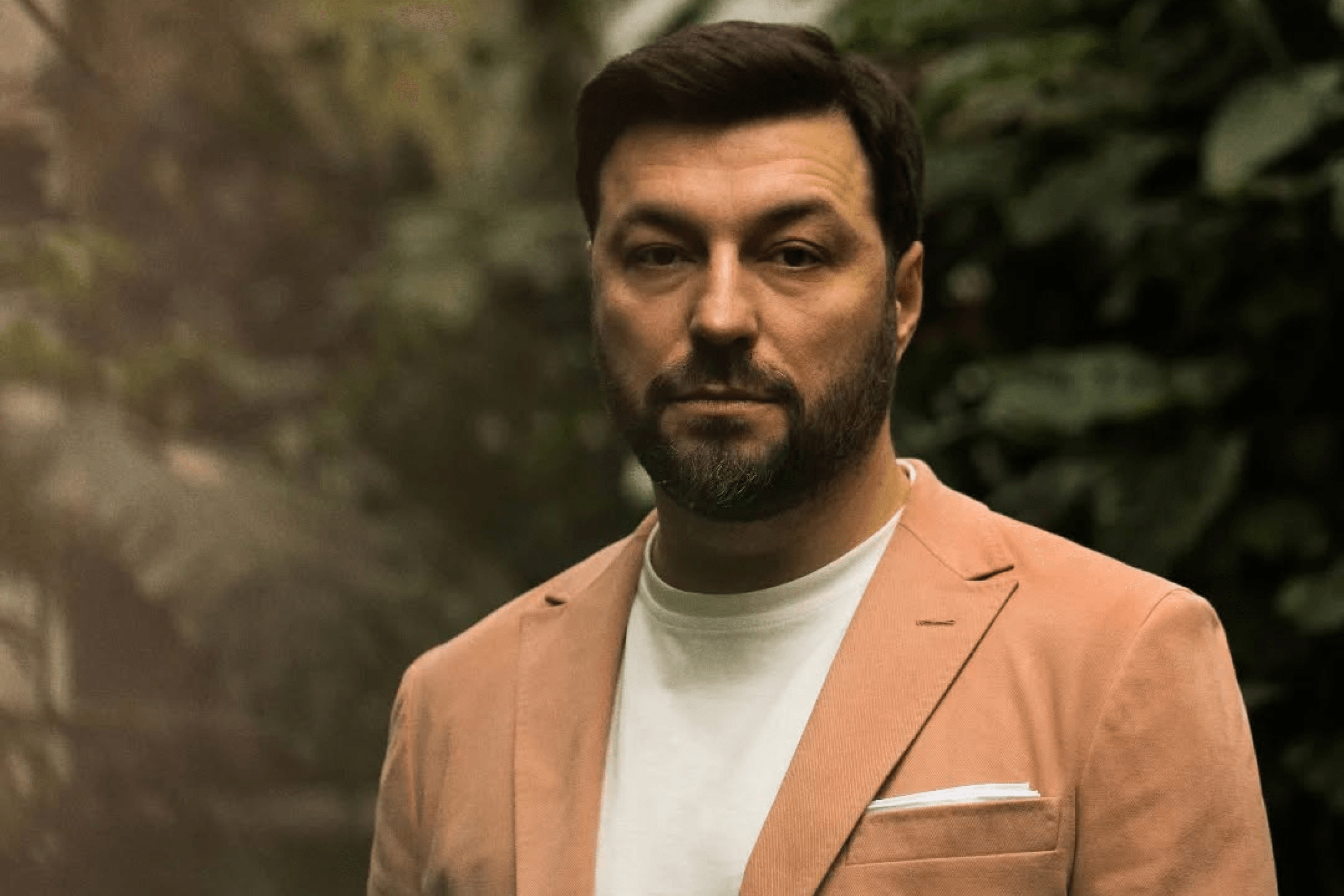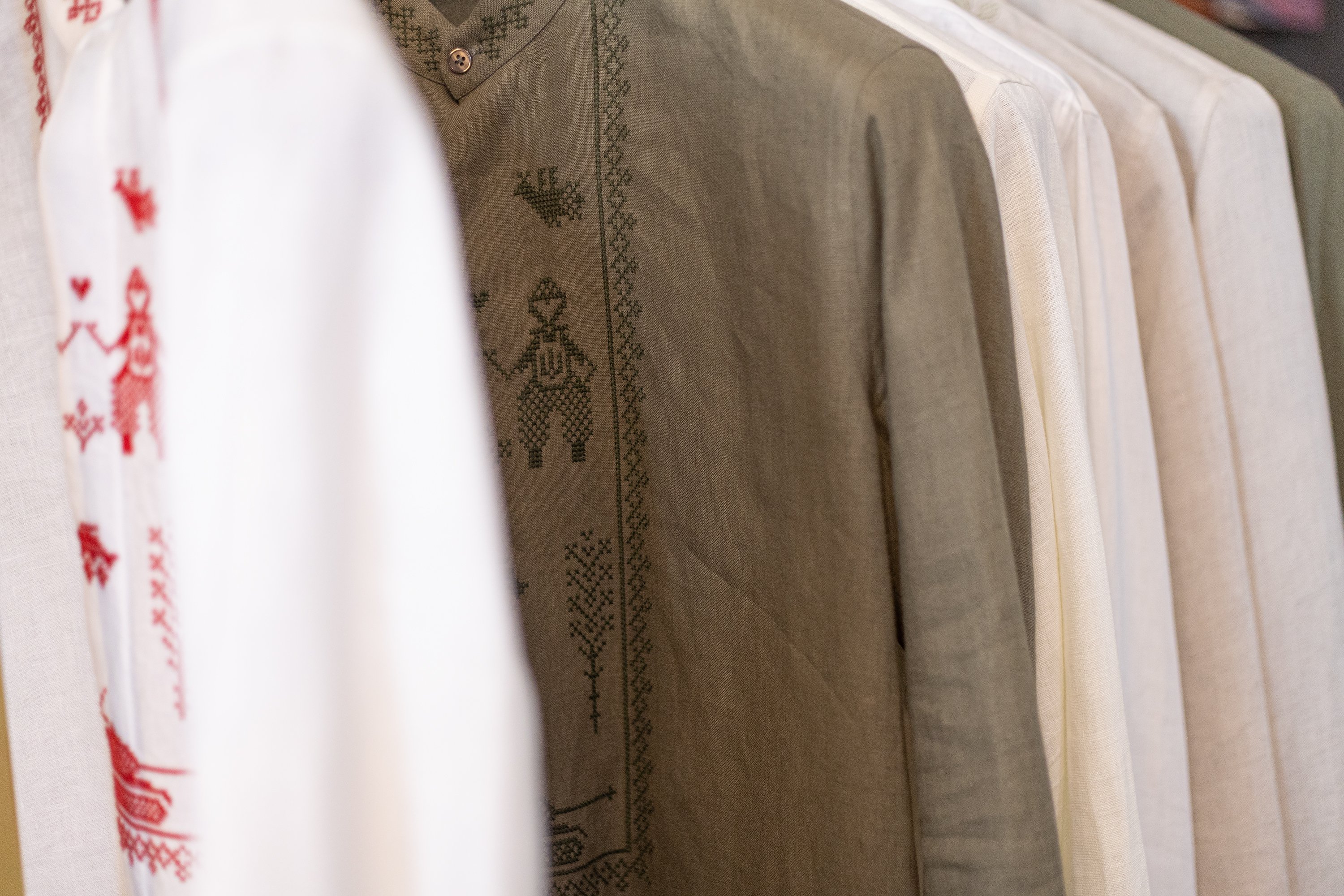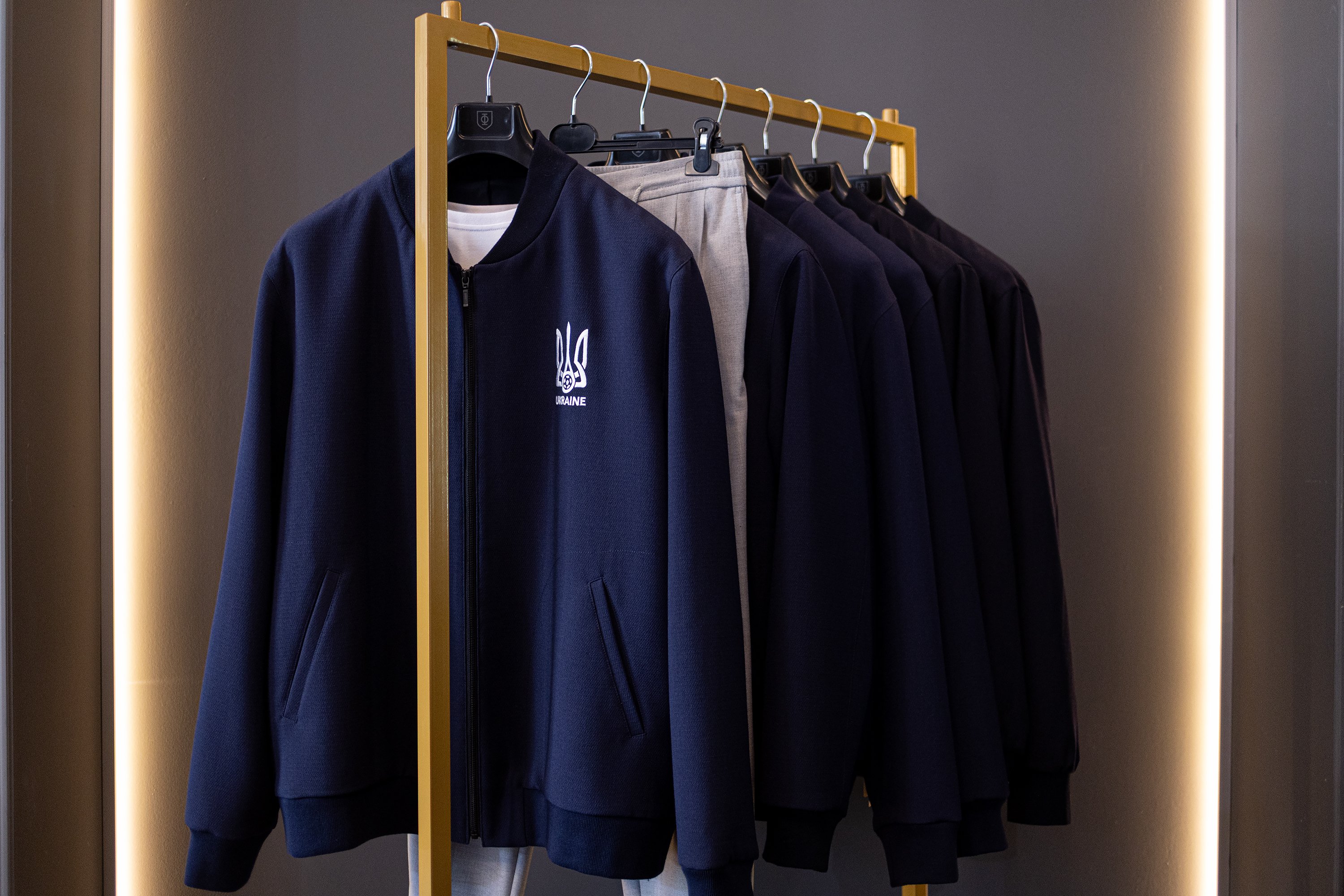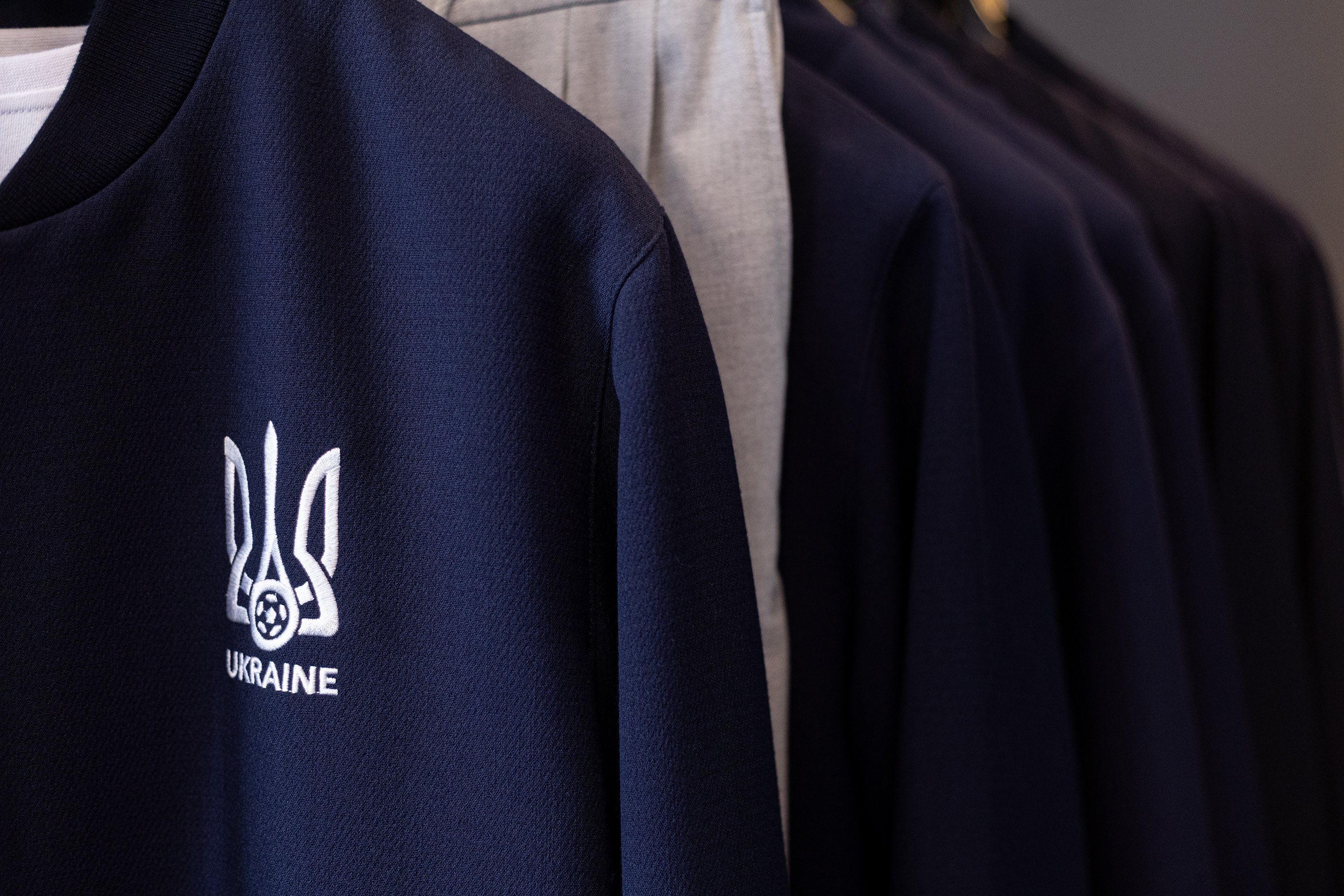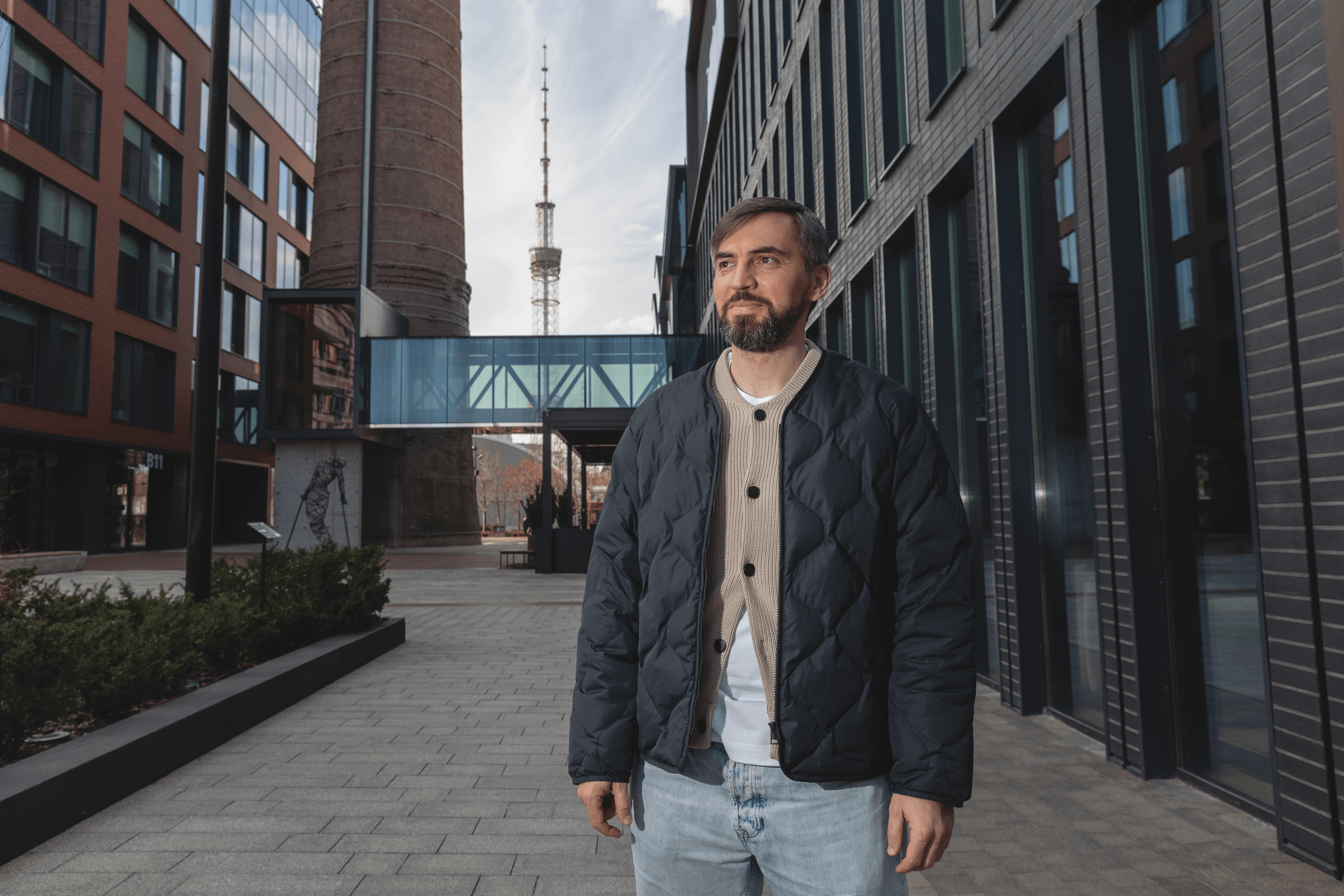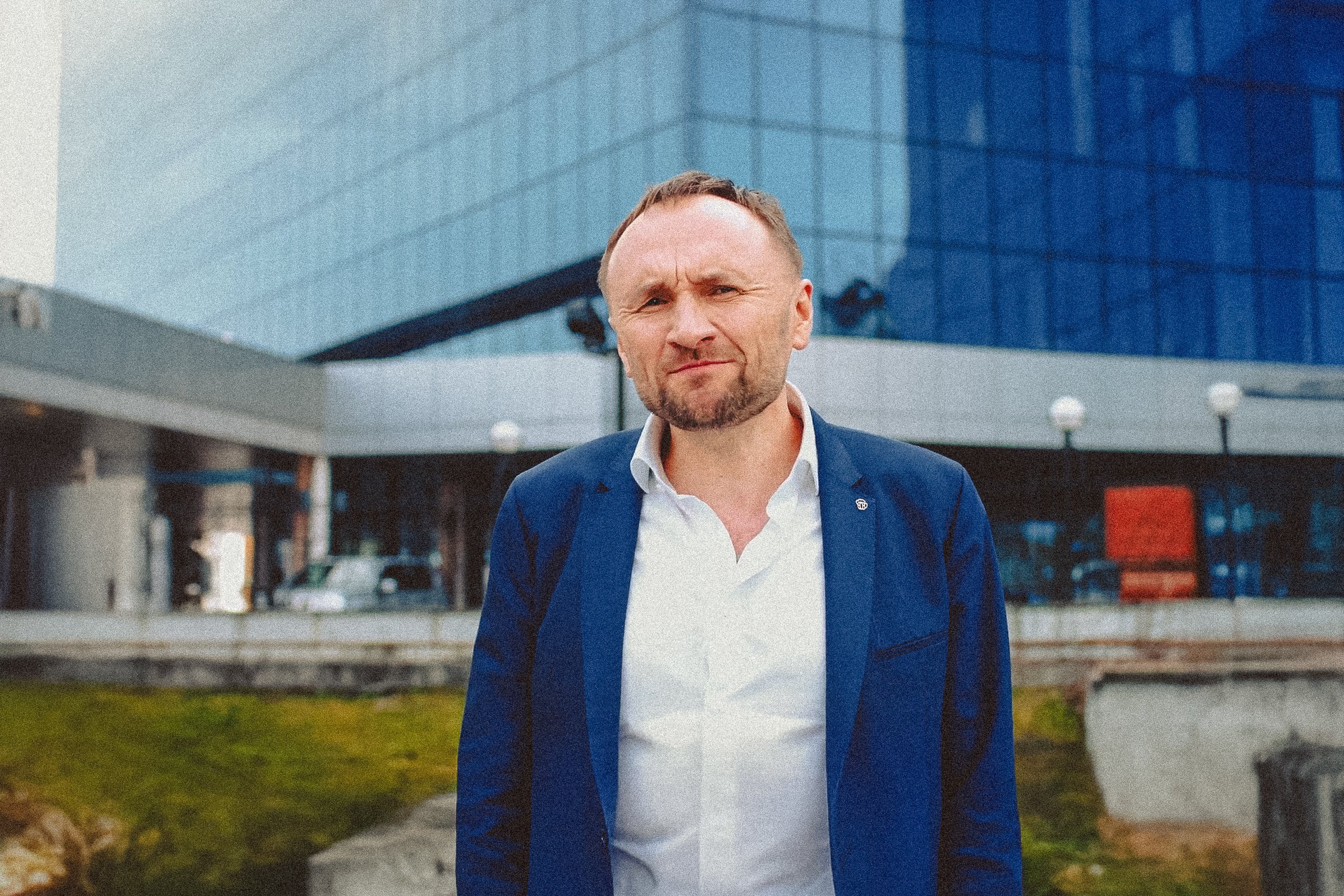In 2009, 25-year-old Ukrainian entrepreneur Kateryna Vozianova founded Indposhiv, a brand of classic men’s clothing. The three-person team started out in a small apartment in central Kyiv, with Kateryna’s friends as their first clients. Sixteen years later, she has grown the client base to over 3,000 people, and her team has crafted more than 12,000 made-to-measure garments. An Indposhiv suit costs approximately $1,800–2,400, depending on the type and price of the fabric.
The brand is represented by some of Ukraine’s most influential and recognizable figures — among them President Volodymyr Zelenskyy, Ukraine’s ambassador to the UK Valerii Zaluzhnyi, UN ambassador Sergiy Kyslytsya, and Azov soldier Illia Samoilenko, known by the call sign “Gandalf.” For about ten years, Indposhiv has been active on the international market.
Since 2014, Kateryna has been traveling with trunk shows to London, and starting in 2024, to Vienna, where most of Indposhiv’s clients relocated after the full-scale invasion. Working with clients is like something out of a movie — clients browse numerous catalogs of fabrics and accessories, a stylist helps with the selection, and a tailor takes measurements. After that, clients attend one or two fittings during which the tailor adjusts the suit to fit perfectly. Within 8 to 9 weeks, the Indposhiv team creates clothing that fits flawlessly.
- Kateryna Vozianova is a 41-year-old entrepreneur from Kyiv. Before starting her own business, she worked as a marketer for major companies such as Gillette and Procter & Gamble. In 2009, she founded Indposhiv — a brand of classic men’s clothing tailored to clients’ individual measurements.
- Since 2014, a small part of the Indposhiv team has been traveling monthly with trunk shows to London. However, due to COVID-19 quarantine restrictions and later the full-scale invasion, Indposhiv temporarily suspended its international trips.
- In 2022, the brand launched a ready-to-wear collection available on the Indposhiv website. The collection includes accessories, vyshyvankas, t-shirts, shirts, trousers, shorts, blazers, and outerwear. In August 2022, Ukrainian President Volodymyr Zelenskyy wore a khaki vyshyvanka from the collection. In 2024, Indposhiv returned to the international market and now travels monthly with trunk shows to Vienna. In 2025, the company employs around 50 people, 80% of whom are craftsmen who create the suits. Each month, they produce 30 to 35 suits, which is half the number the brand made before the full-scale invasion.
Before the interview, Kateryna Vozyanova is sitting in the bar of her members-only Indposhiv Bespoke House. The interior, which she designed herself, matches the classic Indposhiv suits — elegant, minimalist, and inspired by the spy films Kingsman. This is her first time back in the building after a business trip. She has just returned from a trunk show, a monthly trip to Vienna where she and a tailor meet clients in a city-centre apartment. Nearly half of the buyers there are Austrian.
Regular business trips and a fast-paced work rhythm are routine for Kateryna. At Indposhiv, she handles marketing, sales and the brand’s image, for example choosing the face of each collection. This often turns out to be an Indposhiv client, someone Kateryna meets while they are relaxing in the bar of her members-only building.
Before founding Indposhiv, you worked for six years as a marketer at major companies like Gillette and Procter & Gamble. How did the idea for a classic menswear brand come about?
In 2009, at the age of 25, I left Procter & Gamble to work with my father, Fedir Vozyanov. He’s a very talented designer with a sharp eye for quality, and his product is honestly really good. But very few people knew about him, even though he was one of Ukraine’s first designers. I understood why — he lacked marketing and a clear business vision. I thought I could step in and build a solid business system that would work. But as soon as I started, we began to clash. He said I might ruin everything with my big-company FMCG mindset. I completely disagreed, so I said, “Papa, ciao.”
My ambition wouldn’t let me go back to the FMCG world. I had already told everyone I was starting my own business. Together with my assistant, I explored possible ideas, more or less knowing the market. I thought about it not from a consumer’s point of view but from a manager’s perspective — how to hire employees and what their costs would be.
We decided to focus on menswear because it didn’t require a large investment or much design work. Classic menswear isn’t really about design, and we felt we could manage it ourselves.
Who were Indposhiv’s first clients?
My boyfriend and his friend were our first clients, and we practiced on them to understand how the suit-making process works, how long it takes, and how many fittings we need. In other words, we were working out the entire system. The third client was a foreigner, the general manager of an insurance company’s Ukrainian branch, who came to us through online ads. He ordered a three-piece suit. Another one of our first clients was my husband’s friend Maksym Nefyodov, who is still with the brand today.
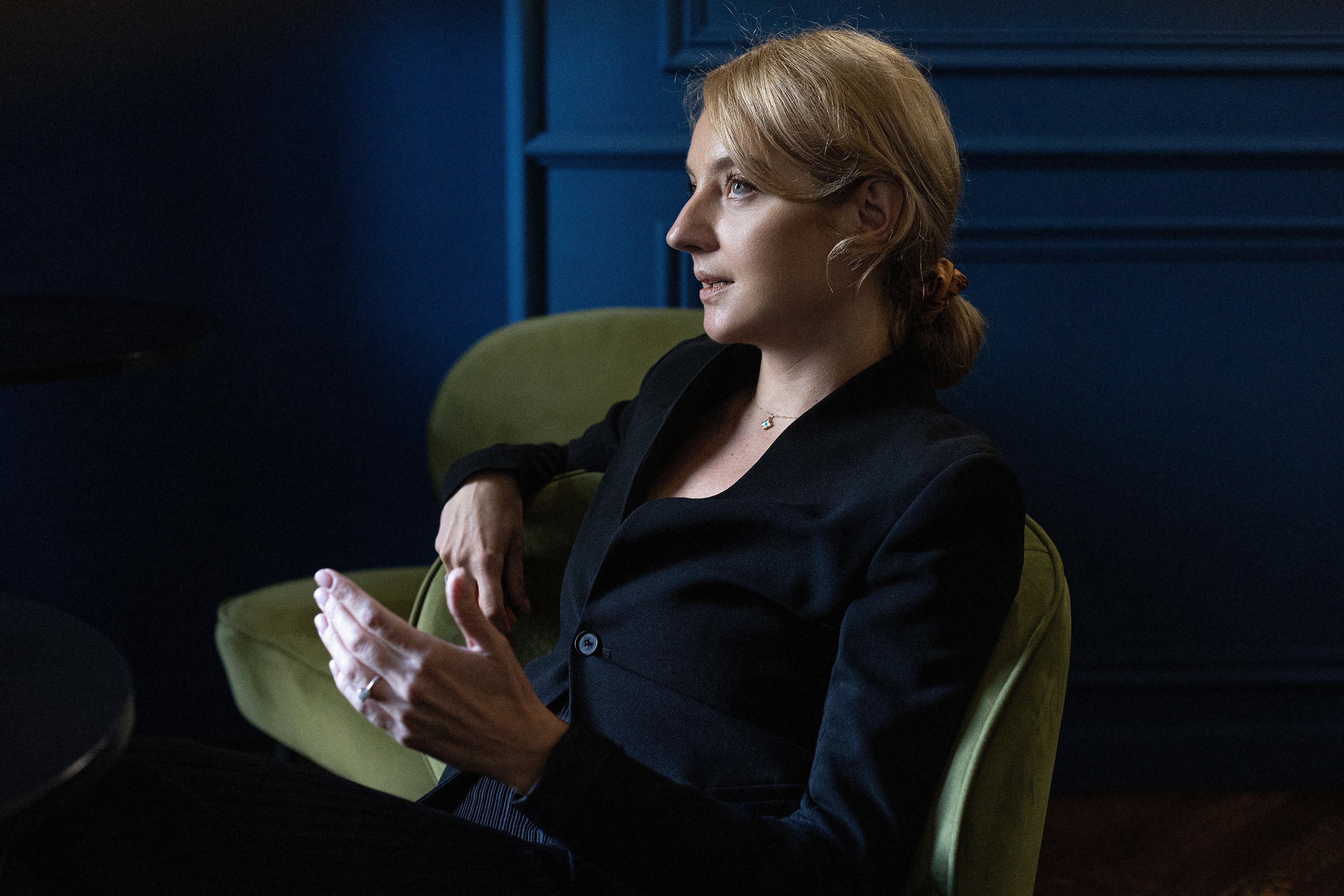
Who were the initial investors in Indposhiv?
We didn’t have any back then, and that hasn’t changed. We started Indposhiv with money from my last paycheck at Procter & Gamble, about two thousand dollars. The business model for custom tailoring doesn’t require large investments. We rented the equipment, and I managed to negotiate a very low price — it cost us next to nothing. At that time, I knew that even if we had no orders for a month, I could cover rent and pay my small team of two people: my assistant and the tailor, using my savings. We started during the 2009 crisis, which actually had some advantages. First, many spaces were available for rent at bargain prices. Our concept was for the office to be in a historic building in the historic centre of Kyiv. But honestly, our first space looked terrible. We did a small renovation with our own hands in two days, but it still wasn’t great. Second, many people were laid off. At the time, I thought the market had plenty of specialists. Later, I realized that the best and most talented people weren’t the ones being let go. Still, we managed to find professional staff.
Over the years, our team has grown to more than 50 people, including five of the country’s top cutters, talented craftsmen, managers, and stylists. Each suit is made by a whole team: a stylist who stays in close contact with the client and helps them choose fabrics and styles; a cutter who makes sure the suit fits perfectly; a fabric cutter; the cutter’s assistant; a pattern maker; and skilled tailors who handle the fabric, sew the suit, and do all the handwork, like embroidering the client’s initials.
When did you first enter the international market?
We started working in London in 2014. That came after two key moments. In 2013, we invited a well-known tailor from Savile Row to assess whether our suits met the standards of the British tailoring guild. It was his first time in Eastern Europe, and he was impressed to find a workshop in Ukraine producing suits of such high quality. He confirmed that we were indeed meeting those standards.
We asked him in detail about how things worked on Savile Row. What surprised me most was that they had a long waiting list — yet didn’t advertise at all. At the time, their suits cost about £3,000 and took four to six months to make. That didn’t stop clients from getting in line and waiting. They also went through three to six fittings to receive their suit. Meanwhile, our clients often said even two or three fittings felt like a lot…
In 2014, the owner of a London-based agency that promoted Ukrainian businesses in the UK reached out to us. He said he had heard a lot about our work and wanted to collaborate. He would bring in clients and we would produce the suits on a partnership basis. That was the moment we realized that our quality met the highest standards, our service was even better than at some Savile Row ateliers, and we were ready to work in London.
That same year, we held our first trunk show. I wouldn’t call it a big success. It was challenging, especially because we were up against strong competition that you can’t easily research online. Many of the ateliers there do not even have websites. One of our mistakes was focusing too much on Savile Row, while in reality, many tailors were coming to London for trunk shows from Asia and Eastern Europe. Still, it was a very interesting experience. Then COVID started, followed by the full-scale war, and we stopped doing trunk shows altogether.
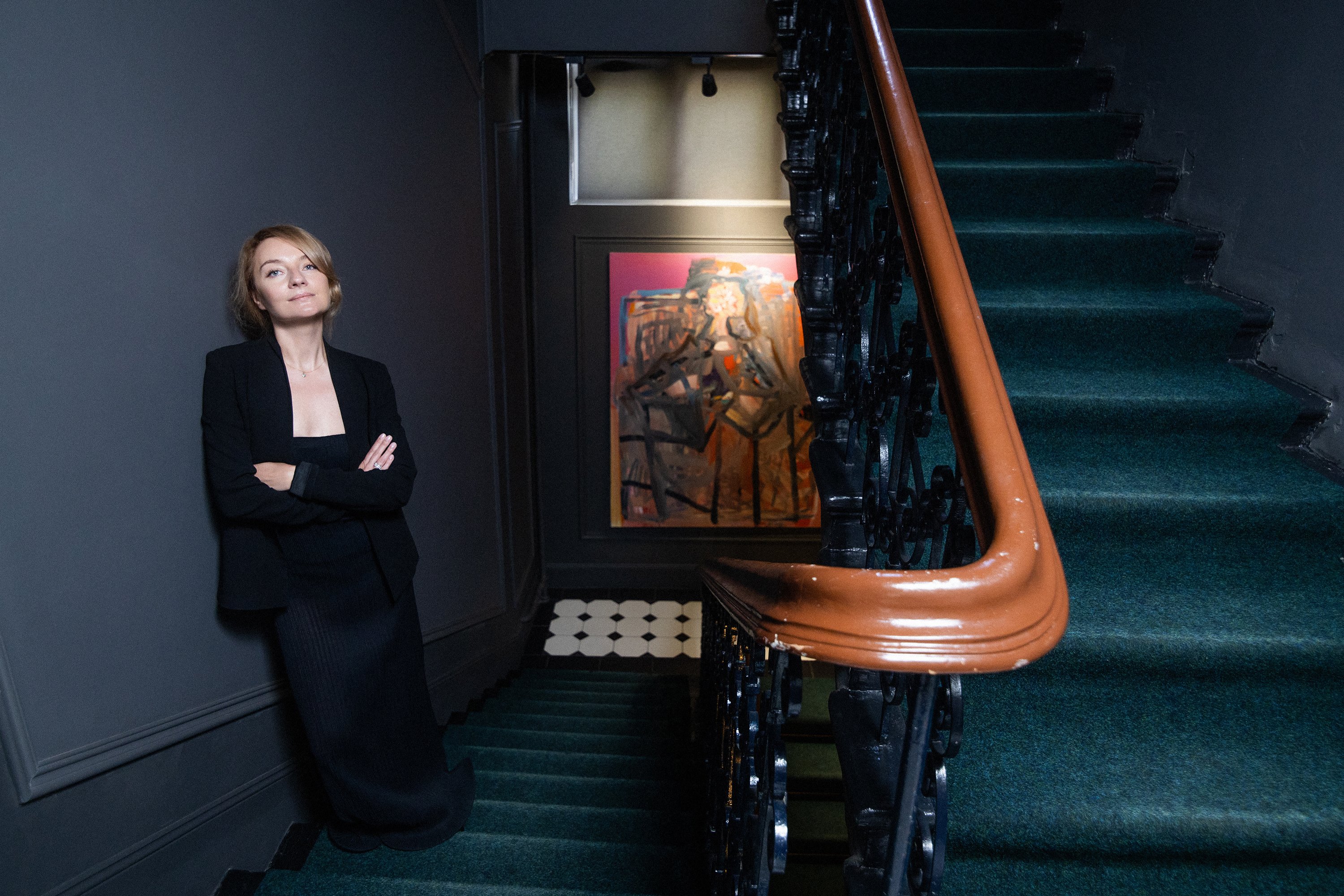
How did you operate at the start of the full-scale invasion?
In March 2022, we introduced a €350 gift certificate for any Indposhiv order, sold at the pre-war exchange rate. Around 60 people bought them, and thanks to that, we were able to pay salaries that month, even though no one was actually working at the time. It showed us that our clients truly are some of the finest men in the country. That’s why we felt we had to do everything possible to stay on the market for them.
Our first order came in May 2022. It was a wedding suit for a young man who found us online. At the time, there were just three of us on the management team, and I was also acting as the stylist and front desk. I assumed they were getting married abroad because in May 2022, no one really understood what was going on. But he said no, they were having a traditional Ukrainian wedding near Poltava. That’s when we realized that if someone is ordering a wedding suit in spring 2022, not all is lost, and we have to keep going.
Did your suppliers support you?
Yes. Many companies were very understanding and offered us payment deferrals. Unfortunately, we couldn’t control the exchange rate or logistics. We buy fabric specifically for each order. It used to arrive smoothly via DHL, but when DHL stopped operating, we had to find alternative ways to get the fabric.
You launched the women’s suit line Heroism a year before the full-scale war. Is production on hold?
Marketing for Heroism has paused, but sales continue steadily. Women consistently order something classic every month. Why did marketing stop? With the full-scale war, I simply don’t have the resources to manage two businesses. Heroism operates out of the same building with a small, separate team focused on women’s suits. We’re not actively expanding the line right now. I know it sounds harsh and not like the way you’re supposed to run a business, but right now all my energy is focused on Indposhiv. Heroism is great — we make fantastic suits and have wonderful clients. Once I’m confident that Indposhiv is stable, maybe then my inspiration for the women’s line will grow.
How many women are in your client base?
Up to a hundred.
Indposhiv makes custom ceremonial uniforms for military personnel. How often do military clients come to you?
Quite often. We started making ceremonial uniforms because that segment was underserved. It’s actually one of the most rewarding parts of my work. When we launched the ceremonial line in 2024, we decided to make twelve free suits for military men getting married this year. We selected them randomly — guys submitted applications. They were all very different, of various ages and from different regions, but all bright and amazing people. For these individuals, you want to do everything you can because they’ve done everything so you can live, work, and pursue what you love.
2
In the workshop on the second floor, patterns and suits hang from rails. Among them are two ceremonial uniforms for the National Guard. The atmosphere here is quite different. With upbeat pop music playing in the background, tailors work on suits for Austrians, Ukrainian politicians, businessmen, and military personnel. Above each cutter hang the garments they are working on, with around ten orders assigned to each of them. Indposhiv completes a suit in eight to nine weeks, significantly faster than global bespoke brands, which often take anywhere from three months to a year. Kateryna’s team includes fifty people, forty of whom are directly involved in garment production. Clients interact with just two: the cutter and the stylist, who take measurements and help define the perfect suit.
In the workshop, Kateryna fits in naturally. She quickly finds everything needed for the photoshoot without getting in the way of the workers moving around. She watches the cutters at work and glances at their schedule hanging on the wall, noticing that one of the workers hasn’t added their vacation time. Since the start of the full-scale war, Kateryna has been managing most of the processes at Indposhiv on her own. For example, in Vienna, Kateryna takes on the stylist’s role: she notes the client’s preferences, shows fabric samples in catalogs, and discusses details like buttons and the jacket lining color. She works alongside a cutter who takes measurements and pays close attention to the client’s body shape to create a suit that fits perfectly.
In March 2024, you returned to the international market. Why did you choose Vienna over London?
First, most of our clients who left due to the full-scale war are now based in Vienna. Second, the logistics to Vienna don’t take much time. It’s currently a two-day trip each way plus two full working days.
How do foreign clients perceive suits compared to Ukrainian clients? Do they have different requests?
Absolutely. The main challenge with Ukrainian clients in our segment is that they’re not very familiar with the concept and value of bespoke tailoring. For them, buying a well-known brand is far more prestigious than having a suit made in an atelier. For over sixteen years, we haven’t just been running a business — we’ve been building a bespoke culture in Ukraine. We say that a custom-made men’s suit is the pinnacle, the best a man can invest in when it comes to classic clothing.
This is quite unlike Austrians because they have another culture. They understand that a bespoke suit is a work of art, a masterpiece, as each one is made individually. They’re more knowledgeable about fabrics and their makers, and less concerned about brand names. In Ukraine, our best-selling fabric brand is Loro Piana because it’s widely recognized. But there are many other excellent fabrics from lesser-known makers.
Do you have different marketing strategies for clients abroad and in Ukraine?
From a marketing perspective, we don’t really separate our clients. We use targeted ads and participate in events to build brand awareness. Targeted advertising works better with our Austrian clients, while word of mouth is more effective among Ukrainians — people simply share and recommend us to their friends. That happens because our Ukrainian client base is larger. Our Austrian client base is growing gradually, and if we keep working at the same pace in Vienna for another year or so, we expect recommendations from Austrian clients will start to pick up.
Have foreign clients ever questioned the reliability of a Ukrainian brand due to the instability caused by the war?
We haven’t encountered that personally. All of our Austrian clients genuinely appreciate that we continue to operate and uphold both our timelines and quality despite everything. I speak with them directly, they often ask about the war and leave with a deeper understanding and appreciation of Ukraine’s resilience.
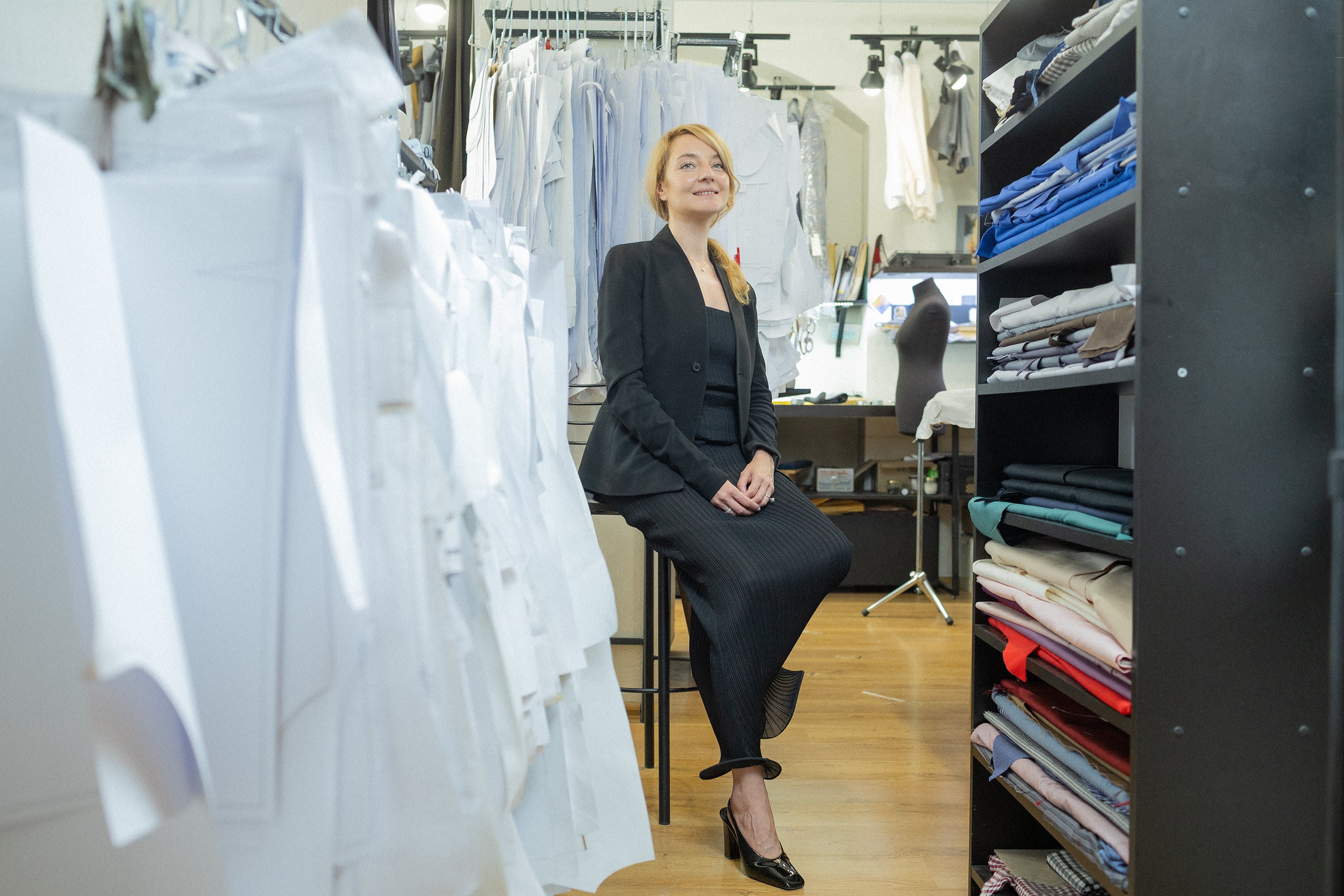
Are you planning to expand into other markets, such as doing trunk shows in the US, Canada, or other parts of Europe?
We don’t have those plans for this year, it’s simply not logistically feasible for a bespoke brand. For us, expansion means traveling to that location every month. Our British colleagues are based in London but regularly travel to trunk shows in the United States, Japan, and other Asian countries because their clients are willing to wait a year for a suit. Ours are not. So either we find a way to come every month to take orders and do fittings, or we don’t do it at all. For us, it’s important to work flawlessly, to offer great quality and service. For now, Vienna is as far as we go.
However, we do ship all our products through our website, including accessories, vyshyvanky, t-shirts, dress shirts, trousers, shorts, jackets, and outerwear. The only way for us to expand is to have our collection carried by retailers abroad. But to do that, we need to scale up production enough to offer a full collection, not just a drop. Right now, that is very challenging because it requires significant investment. On top of that, it’s not easy to find the right people to hire right now.
3
We return to the bar area in Indposhiv Bespoke House. On the windowsill, in a special stand, rests an A4 sheet in a frame bearing the words and autograph of one of Indposhiv’s clients: “No matter how hard things get, at least we won’t be ashamed.” This item was auctioned during Indposhiv’s sixteenth anniversary and was donated by the former Commander-in-Chief of the Armed Forces of Ukraine and Ukraine’s Ambassador to the UK, Valerii Zaluzhnyi, who has been wearing Indposhiv suits since December 2024. The man who won the auction left his autograph at the house so it can be auctioned again.
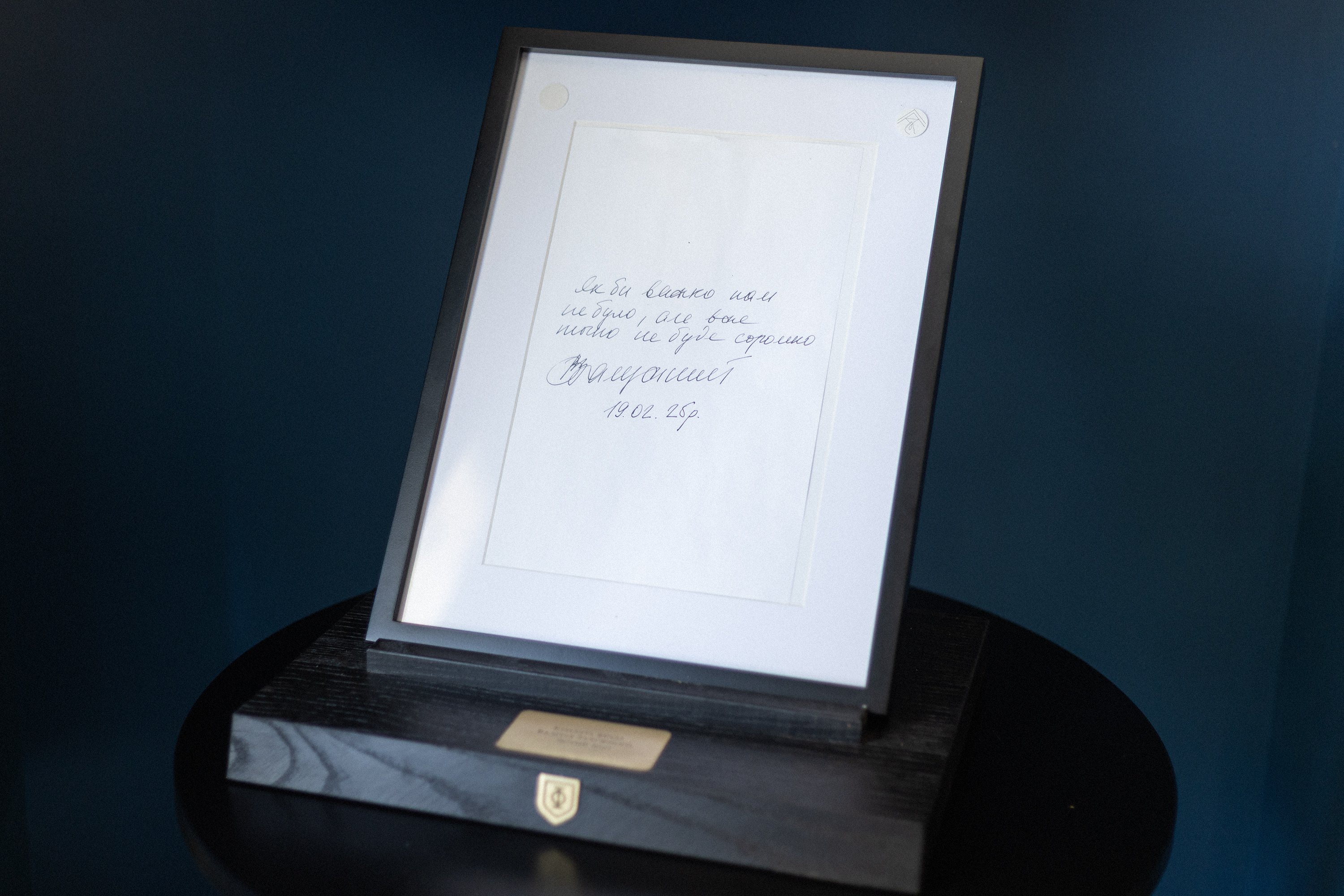
One floor below are two fitting rooms and a shop featuring Indposhiv’s ready-to-wear products: t-shirts, dress shirts, vyshyvanky, accessories, and casual suits that are quickly adjusted to fit clients’ measurements. The receptionist asks us not to go down to the second floor during the interview, as a stylist is currently working with a client in one of the fitting rooms.
In 2022, you launched a ready-to-wear line, even though you previously said it was your taboo. Why did you change your mind?
First and foremost, we needed to keep our production running. We had fabric stock but very few orders. At the start of the war, we offered a 40% discount on suits but also cut salaries by the same amount. We had to restore salaries and prices and adjust them for inflation. Before the full-scale war, we had about 60 suit orders per month. Afterward, just ten was considered a success. The tailors really had nothing to do. These are the skilled hands of the country, carefully selected over a long time, and we couldn’t afford to lose them.
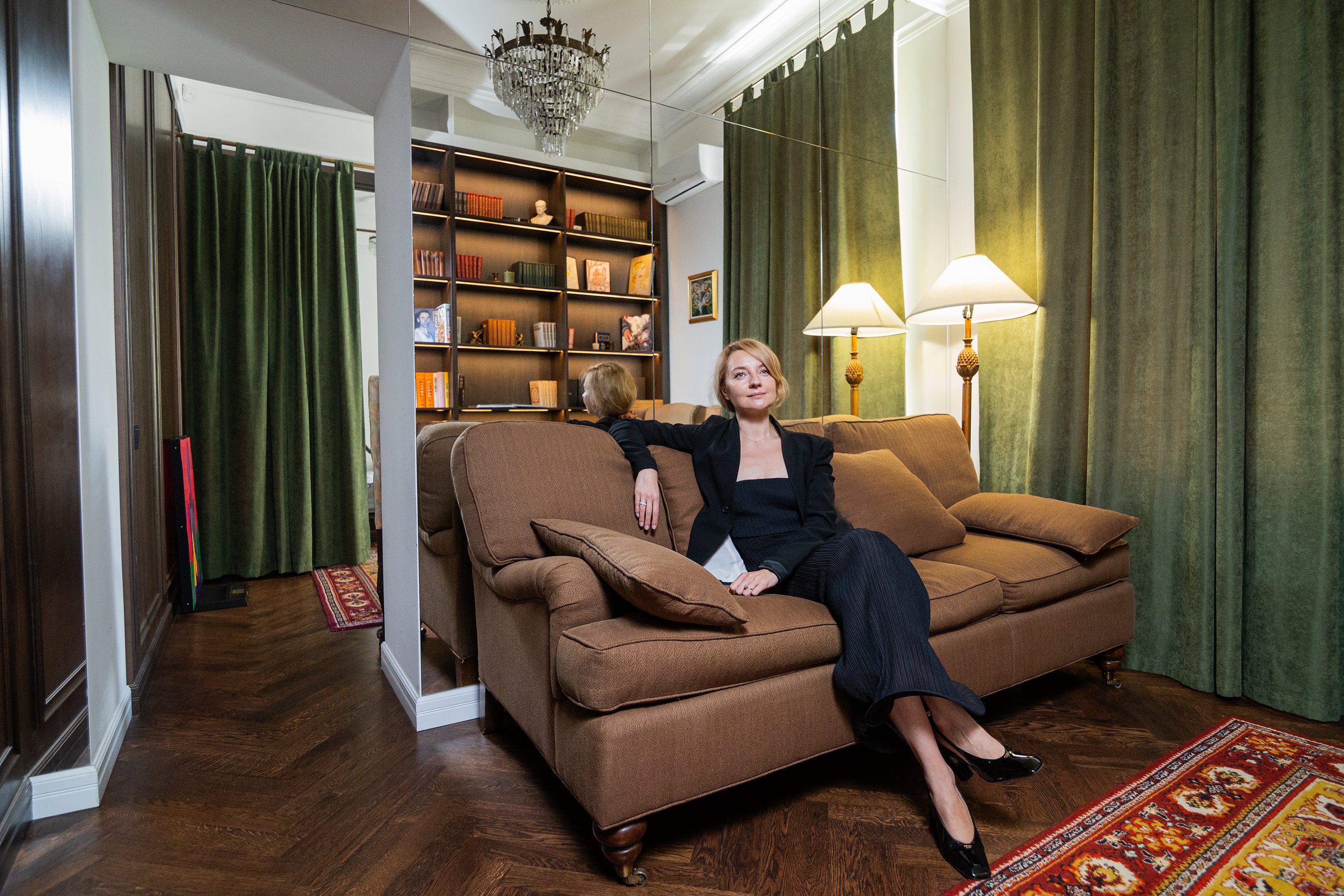
Second, ready-to-wear can be ordered from anywhere in the world, which expands our market geographically because we are no longer limited to Kyiv where physical fittings are necessary. Third, I realized this was a turning point for us as a Ukrainian company. We could finally attract people who had never thought about classic men’s clothing from a Ukrainian brand before, and now that matters to many. Yes, they’re not ready for bespoke yet because it requires time, process, and money, but ready-to-wear made with the same technology can now be bought from a Ukrainian brand rather than an Italian one as was the case before the full-scale war.
Your collections have featured public figures such as serviceman and human rights advocate Masi Nayyem, as well as Ukraine’s ambassador to the UN, Sergiy Kyslytsya. How do you choose the faces of your campaigns? Are they your clients?
Not everyone we feature starts out as a client, but they always become one. It’s our little hook. We choose people whose values resonate with those of our brand. It’s a deeply personal decision, and honestly, I don’t think I could hand that process over to someone else. We’ve tried to select based on certain criteria — someone who’s well known, involved in supporting Ukraine, in the military, or working in a vital field like energy, as [Yasno CEO] Serhiy Kovalenko does. But it never quite works when we approach it that way.
What I do know is that it’s better to delay a collection than launch it without the right person to represent it. And somehow, the right person always appears. Some of our heroes are tied to truly incredible stories. It’s not really a business strategy. It’s just how things have unfolded during this war.
In 2023, the face of your “One of a Kind”campaign was Ilya Samoylenko, a serviceman from the Azov Brigade known by the call sign “Gandalf.” You previously mentioned that while he was in captivity, which began in May 2022 after the siege of the Azovstal steel plant, he thought about walking around Kyiv wearing one of your suits. How did your collaboration with him come about?
His stylist reached out to us. He needed a classic blazer for a speech the day after tomorrow, so there was no time to tailor anything from scratch. We found a ready-made blazer and just lengthened the sleeves a bit. We told him he didn’t have to return the blazer since it was a small gesture of gratitude from us. But he still came back to return it and stayed in the bar area of Bespoke Indposhiv House. That’s when we began chatting, and he shared that he’d known about us for a long time and had thought about our suits while in captivity. We didn’t have a budget or a long-term marketing plan, but we knew we had to do something together. That’s howthis campaign was born.
Do your advertising campaigns help convey the context Ukraine is living through to foreign clients? What message are you sharing through your brand?
My goal is to show the world what a modern Ukrainian man looks like. When people hear the words “Indposhiv” or “bespoke,” they usually picture a politician, a lawyer, or a businessman. Cigars, fancy cars, the dolce vita. But I wanted to show who our audience really is today. Some have swapped suits for military fatigues. Others are fighting on different fronts, not just on the battlefield.
The ready-to-wear collection featuring lawyer and veteran Masi Nayyem drew a strong response.
Another standout piece was the military-style vyshyvanka, worn by President Volodymyr Zelensky in August 2022. It caused such a hype that it’s still one of our most popular items, with many orders coming from abroad.
You’ve been working with President Volodymyr Zelensky since 2019, right? He appeared on the cover of Vogue wearing one of your blazers.
Yes, before the full-scale war, we used to make classic suits for him. He was a regular client. We would visit him, take measurements, and choose fabrics together. It was the same process as with any other client — just not here at the House, but at the President’s Office instead.
Oscar-winning director Mstyslav Chernov also wears your suits. He accepted his Oscar in one in 2024 and wore another to the 78th Cannes Film Festival in 2025. How did that collaboration begin?
We had a marketing manager who was familiar with the film industry. At the end of February 2024, she rushed in and said, “Mstyslav Chernov’s film made the Oscar shortlist. ‘We’re not sure if he’ll win, but he needs a suit.’ I didn’t know Mstyslav personally, so I reached out on social media. Two days later, he responded, saying it sounded like a great idea.
I wrote back that we’d be happy to welcome him to Kyiv for his measurements.But it turned out he wouldn’t be there before the Oscars — he was in London. Luckily, we still had plenty of contacts in the UK. A team in the UK took his measurements using the British metric system, and we spent a couple of hours with our cutters converting them accurately. For the fitting, we invited a client with a similar build to come in. It turned into quite the operation because it is very difficult to make a suit that fits well without an in-person fitting, but we managed to pull it off.
This isn’t the first time you’ve made a suit using measurements taken by people other than your own tailors, and without fittings on the client. In 2024, you released the non-playing uniform for the Ukrainian national football team. Did the players take their own measurements?
They did, or sometimes didn’t take any measurements at all and just provided their heights. We reached out to the leadership of the Ukrainian Football Association, but in the end, we had to look up some players’ details on Google and Wikipedia when they didn’t send anything. This is also our face, and the clothing has to be top quality. Okay, the bomber jacket doesn’t need to fit like a blazer, and we made extra t-shirts, but the trousers couldn’t bunch up at the bottom. I called our former seamstress who had moved to Germany. Ira went to the base in Wiesbaden with a portable sewing machine and spent two full days hemming trousers and doing fittings. Because getting it perfect on the first try is impossible. That was our pop-up workshop in Wiesbaden, and it worked out really well.
Has this collection become popular?
Very much so. The Ukrainian Football Association doesn’t have an official store yet, so this uniform is only available through us. It worked out really well because new clients discovered us through the uniform, and later ordered suits, becoming our regular customers.
4
While we talk, the barista prepares another cup of coffee for Kateryna to help her re-energize after a heavy drone attack on Kyiv overnight. The previous barista was mobilized into the Ukrainian Armed Forces at the start of the full-scale invasion. Kateryna stays in touch with him and, together with the Indposhiv team, helps raise funds for equipment and other essentials. In total, during this large-scale war, Indposhiv has lost twenty-eight employees: four joined the Armed Forces, and the rest fled abroad as refugees.
Do you think that over the past sixteen years you’ve helped make bespoke culture more popular in Ukraine? Is there a movement toward a culture similar to what Austrians have?
Yes, definitely. It’s not just about how many people know about Indposhiv but about those who understand that a custom-made suit is far better than something bought off the rack. Before the full-scale war, we were growing steadily every year. The war changed a lot and during this time fewer people can afford to spend that much on a suit. Our product can’t be cheap since many people are involved in the production and we use high-quality fabrics and fittings. Still new clients keep coming and since 2022 we’ve been growing every year again.
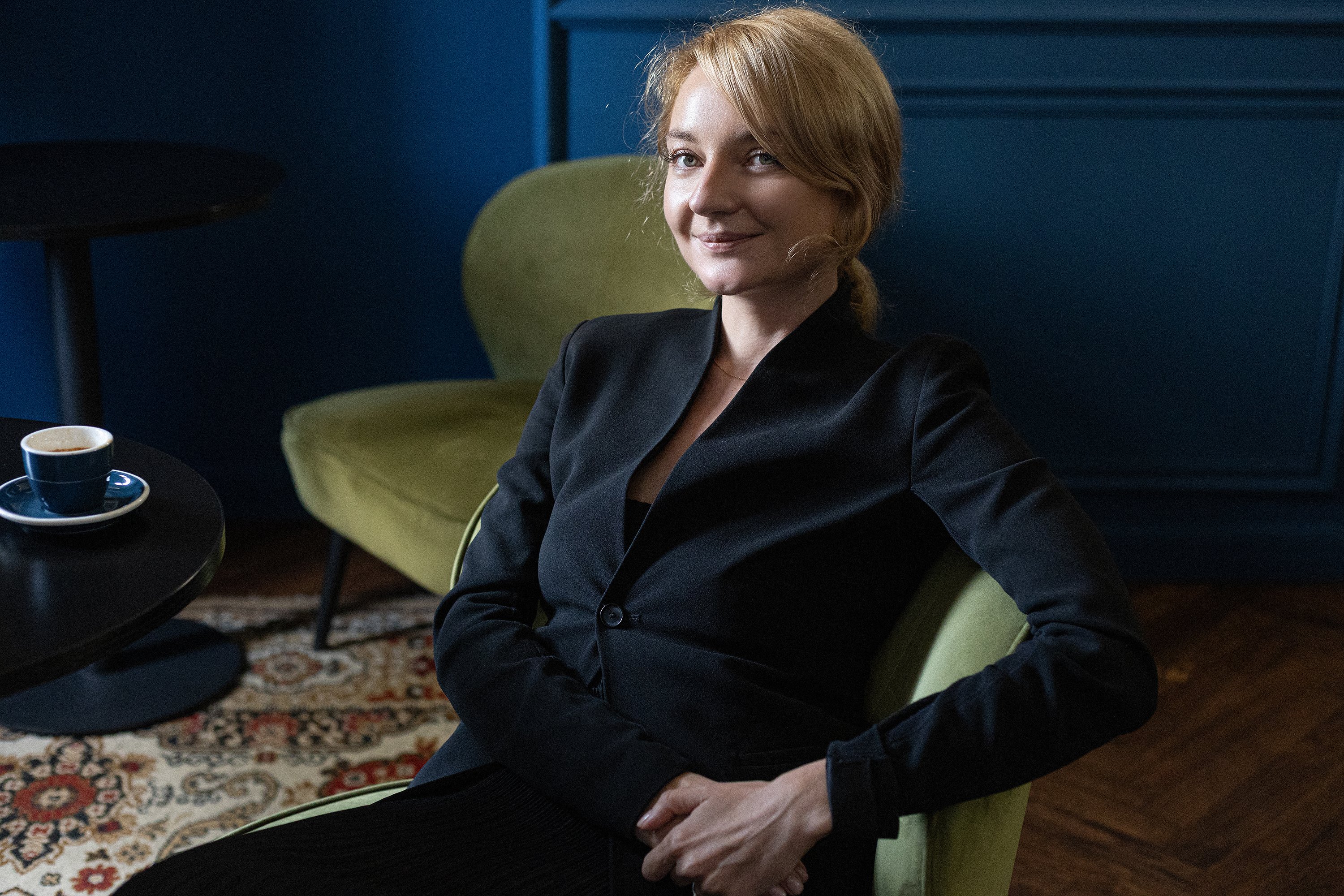
What are the main challenges you face as a business owner during the war?
Right now the biggest challenge is people. They’re hard to find. Many have left the country, and others have changed their relationship to work. Every position here requires someone who genuinely loves what they do. It’s not just about money. It has to feel like their life’s purpose. And that’s where it gets hard. War brings uncertainty, and people are still leaving. Sometimes even our team members become emotionally overwhelmed, and that’s not something I can control. Of course we have a strong team spirit and offer fair pay, but in about half the cases that doesn’t make a difference. People are deeply exhausted by the shelling, and on days like that, we know the pace here slows down. We won’t see the best production results. That’s the biggest challenge.
The second challenge is not knowing what will happen tomorrow. I still don’t know how to get used to that. As a person, you can try to live each day like it is your last, but as a business owner you have to plan ahead and keep your team motivated.
Another issue is that I am running low on personal energy. Everyone is used to seeing me show up every day smiling and full of ideas. But I am a human being, and there was a time when I had no ideas at all, even though people were expecting them from me. I had never experienced burnout before. I have always done what I love, doing what I want and not doing what I do not want. But now we have had so many things that did not work out. You push forward on pure energy, and when an idea does not take off it is hard to pull yourself out of that emotional slump.
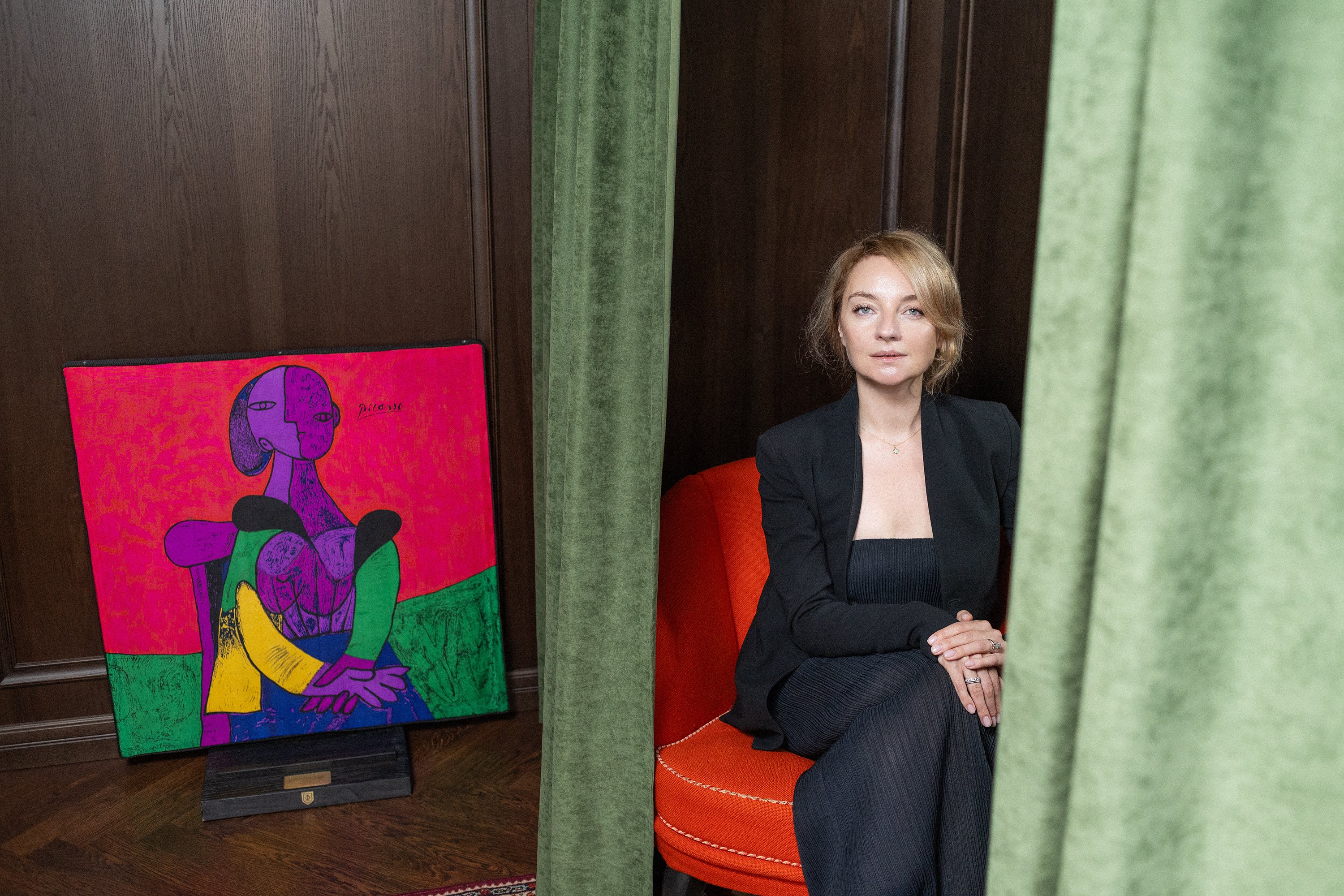
What have you learned as a business owner over these three and a half years of war?
I’ve learned that if you truly want something, you can achieve it, no matter the obstacles. The full-scale invasion made that clear to me. I’ve also come to realize that what really matters is people — not the walls, the stylish bar, or the perfect cocktails, no matter how beautiful they are. In my business, the energy one person brings to another is the foundation. When I’m full of energy, it’s felt throughout the team. But I can’t just step away from it all and go on some round-the-world trip. Before the full-scale war I thought things could be different. It is not about personally handling every process like talking to clients, doing accounting or hiring staff. It’s about my presence, my energy in the business. And I think that’s true not just for me, but for any business in Ukraine today.
I’ve also realized just how incredible people in Ukraine truly are. I have no desire to leave, because I want to be surrounded by people like this. I want my children to grow up among them. The gratitude I feel for these people fills me and lifts me up.
What advice would you give to Ukrainian businesses looking to enter the international market?
I fully understand how difficult it is, especially with so many attacks on civilian infrastructure. Shelling destroys the production facilities and warehouses of Ukrainian brands. But no matter what, you have to hold on and keep going because our products and service are a great source of pride for Ukraine.
Abroad, people are amazed by our commitment to quality and genuine, excellent service. That’s something the world rarely sees. All opportunities and borders are open to us. Of course, it depends on the market segment, but if we have quality, service, and that Ukrainian resilience, then the whole world is ours.
After the interview and photo shoot, Kateryna immediately returns to her daily routine, speaking with the receptionist and her assistant before leaving the atelier to attend to other matters. According to her, since the full-scale invasion began, Indposhiv has shifted from a medium-sized business to a small one. As a result, she now personally oversees many processes, including managing online orders. “You have to keep your finger on the pulse constantly, otherwise you simply won’t survive,” Kateryna says.
